
Skoda Octavia Estate (2013-2020) long-term test
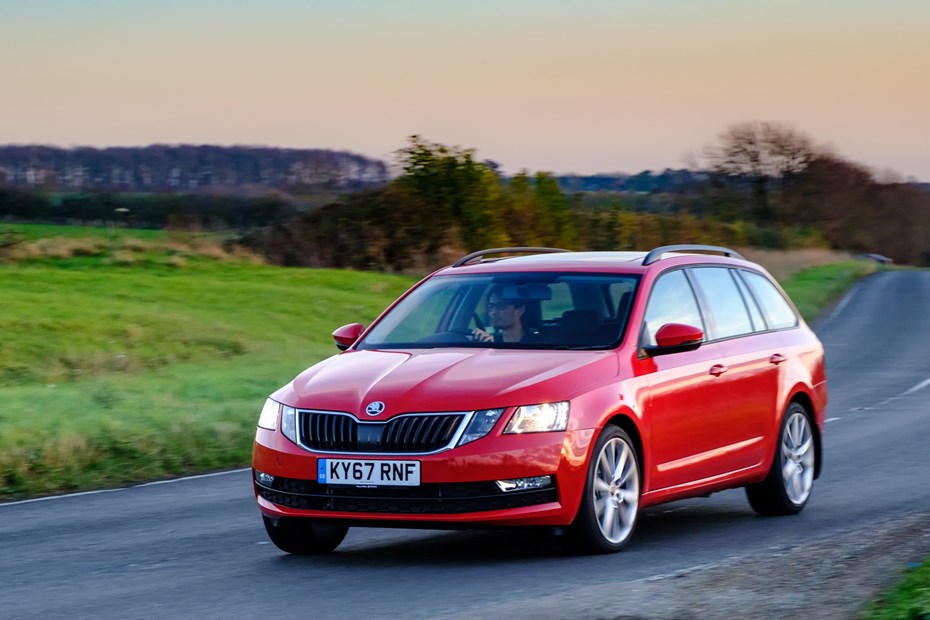
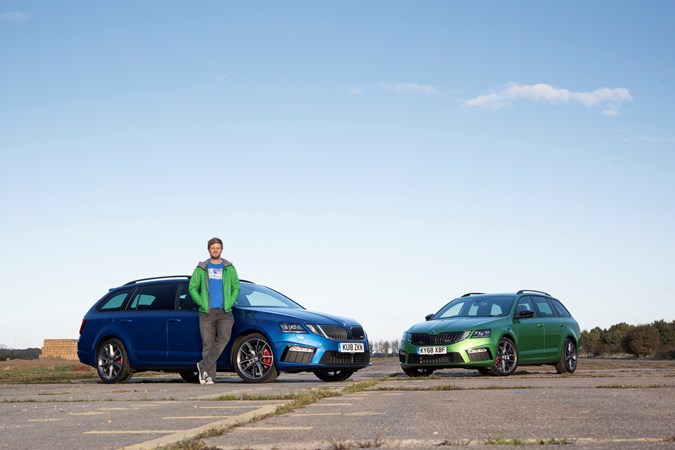
I’ve always said the Skoda Octavia Estate, particularly in vRS format, is the ultimate do-it-all family car. Fast, spacious, comfortable and offering huge value for money, there are few things it doesn’t excel at. Plus you can have it in lime green.
At the time of writing there were many different ways you could spec a vRS – petrol, diesel, manual, auto and two- or all-wheel drive. Complicating things further were two power outputs for the petrol range and a laundry list of options you could add.
I reckon though that the best vRS is the cheapest vRS, and in order to fully test this opinion I lived with two versions of this car for a whole year.
The first was a manual, 230hp Octavia with zero options (save for a spare wheel) and the second was the more powerful 245hp version with loads of additional kit, like adaptive suspension and a DSG automatic gearbox.
So how much money do you need to spend on a vRS to get the best out of it? Well to find out I put these cars through the ringer in a series of performance car and family orientated tests: it gate-crashed our cheap fast car group test, was taken on a surfing holiday to Cornwall and tested on the mountain roads of Snowdonia, and I was taught how to catch criminals in an unmarked version used by the police.
We did some serious journalism too, in the form of a video review, a detailed rundown of the options fitted and whether they were worth it, plus a comparison of all three generations of Octavia vRS to see whether the older versions offered better value for money.
Saving the best for last, I also did more miles with my bike on the roof than in any other car, and took it to an enduro mountainbike race and the Tour of Britain in south Wales to test its credentials as a cycle support vehicle.
You can find my verdict on both cars below, or skip to individual reports using the links above.
Update 1: Welcome
We take delivery of a 230hp manual version of Skoda’s performance wagon

Here’s an idea for a slightly niche feature – ‘Cars That Look Better with Bikes on Them’.
Obviously one of Team Sky’s iconic black and blue Jaguar XF Sportbrakes as (previously) used in cycling grand tours across the globe would be close to the top of that billing, but what else?
Well, fans of more recent Tours De France will be more familiar with the massive fleet of Skodas used by the majority of teams and even the event organisers.
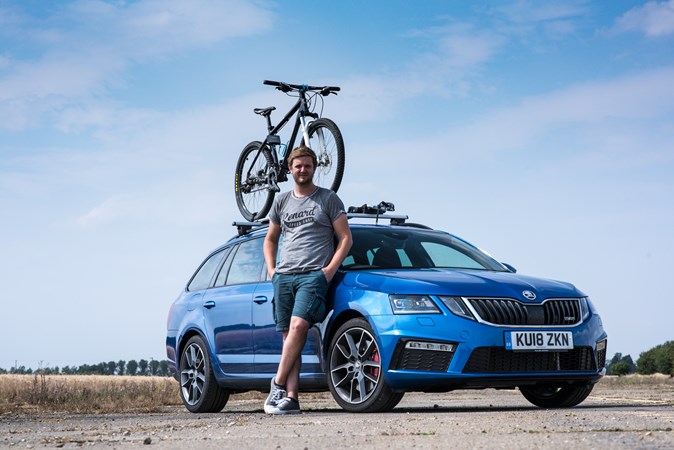
In fact, this year the Czech manufacturer is celebrating 15 years of partnership with the annual cycling race, which is regularly one of the most watched sporting events in the world.
So bikes and Skoda are as close a fit as my cycling shorts and ever-expanding waistline. And just like that aforementioned garment, I suspect this metaphor is starting to feel a little stretched.
Yes. Please get on with it…
I reckon the Skoda Octavia vRS Estate is the ultimate all-round family car – it’s a bit like the hardtail mountainbike pictured above. Fast, hard as nails, good value for money and (in my case) frequently seen with a childseat attached.
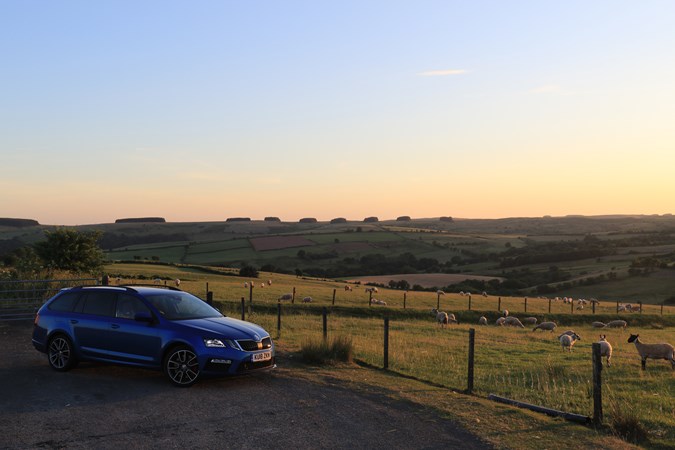
The arrival of a new baby means I now (nearly) have more children than bikes, and that combination makes me the ideal candidate to test its alluring mix of hot hatch performance and family-weekend ability.
Will this Czech wagon live up to my expectations or is a VW Golf R Estate a better bet? Over the next 12 updates I’ll hopefully answer that question.
Wouldn’t a standard Skoda Octavia have done the same job?
Yes but there’s a second thing I want to look at during this test – exactly how much Skoda Octavia vRS do you need?
Pick an entry level manual 230hp estate (like ours) and you’ll pay £26,900 – less than the three-door VW Golf GTI upon which this car is based. Except you get five doors. And more passenger space. And an enormous boot.
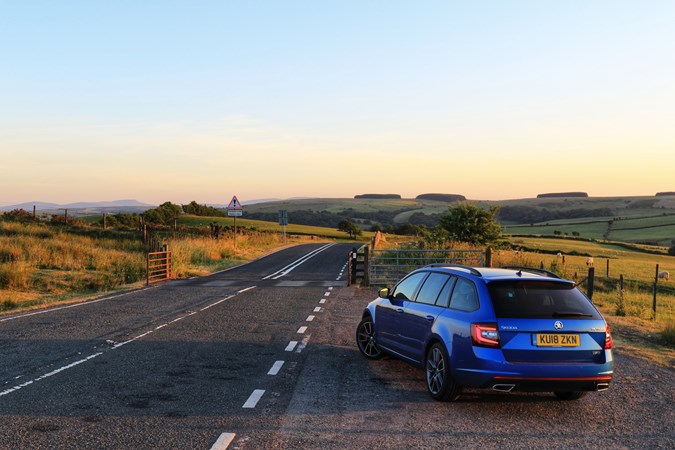
From there you can add all manner of options, including a 245hp version with a mechanical limited slip differential to improve its handling. Thing is, in its purest (and cheapest) form the Octavia vRS makes the most sense.
It has everything you need already – so which, if any, of the available upgrades are worth it? We’ll be swapping into a more extensively specified model to find out.
Any first impressions?
As you can probably tell from the pictures I’ve already taken this Octavia on some bike rides and twisty B-roads and it’s been absolutely flawless at both, but more on that later.
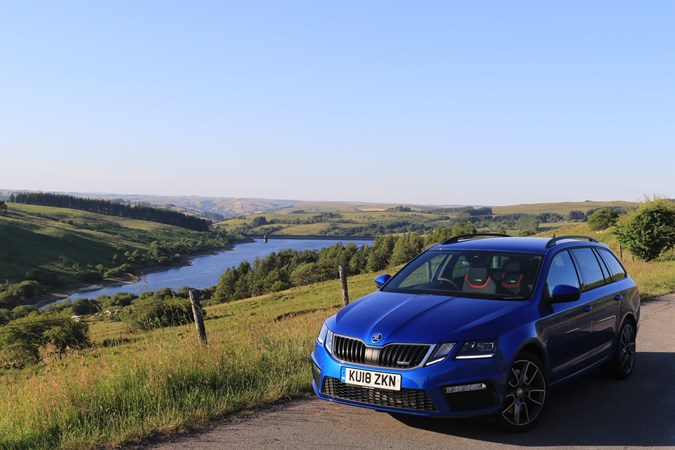
After a few weeks of ‘ownership’ I can safely say this Skoda has satisfied both of my major car requirements – it’s a right laugh to drive and does a great job of conveying my family and bike.
Can it answer the above questions? It’s certainly going to be fun finding out.
Update 2: Spec-tacular
What kit do you get with a standard vRS?
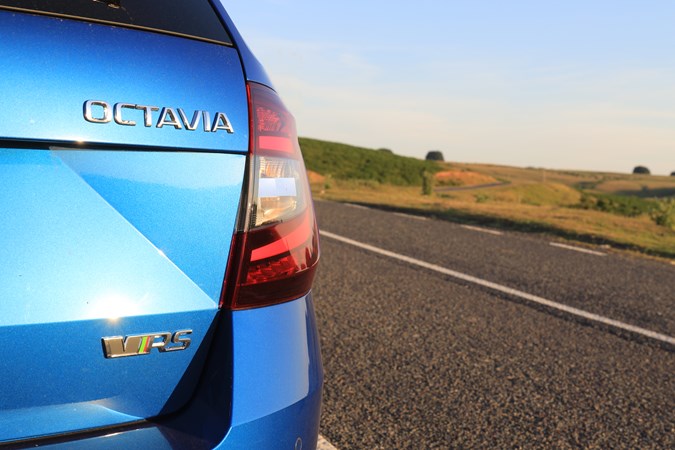
We’ve already seen how the Skoda Octavia vRS Estate is extraordinary value when compared to the mechanically identical VW Golf GTI, but what’s really surprising is how this sportiest (and arguably most desirable spec) is even good compared to other Octavias.
It builds on the SE trim and at £26,900 is cheaper than either the Octavia Scout or Laurin & Klement, so in theory represents a more performance-focussed version of the SE L model.
Granted, you do miss out on a few nice touches that those (more expensive) cars come with – things like heated or electrically adjustable seats, the larger 9.2-inch sat-nav, adaptive cruise and useful variable boot floor.
What equipment is standard on a Skoda Octavia vRS Estate?
A lot, as you will now see for yourself:
Tech
- LED headlights with adaptive front light system
- LED daytime running lights and rear lights
- Lane assist
- Amundsen 8-inch sat-nav with integrated Wi-Fi Infotainment online (one year subscription)
- Electrically adjustable and heated door mirrors
- Light and rain sensors
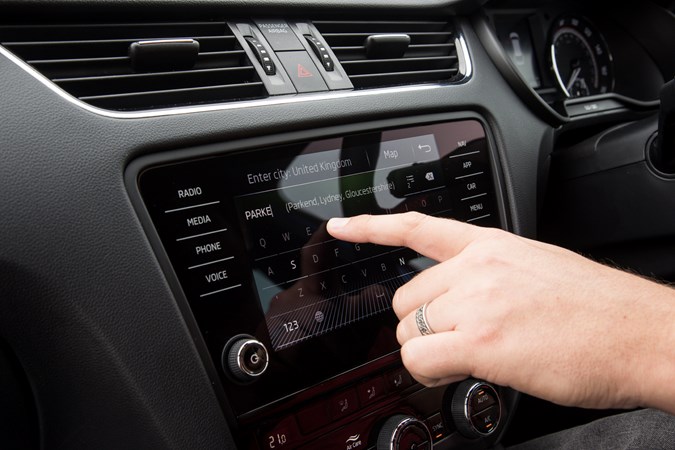
Exterior styling
- 18-inch anthracite alloy wheels
- vRS bodykit (bumpers, spoiler and red brake calipers)
- Privacy glass
Interior trim
- vRS sport seats and upholstery
- Sill trims with vRS logo
- Ten colour front and rear LED interior lighting in doors
- Three spoke leather multifunction steering wheel with vRS logo
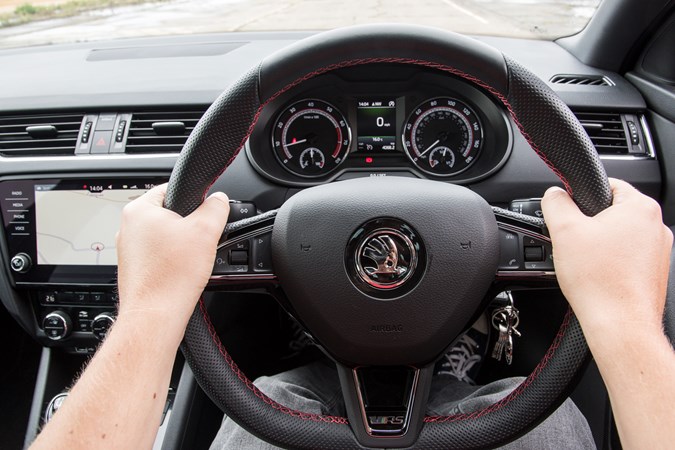
Plus, because this is a Skoda, you get a parking ticket clip in the windscreen, an ice-scraper in the petrol flap and an umbrella under passenger seat.
What options have you got?
None other than a space saver spare wheel. Half way through this long term test we’ll be swapping into an Octavia 245 DSG with options fitted to see which of them are really worth it.
After the first thousand miles we’re not sure we’re missing all that much in this standard car.
Does the Skoda Octavia vRS Estate have a specific engine?
Yes and no – you can get the 184hp diesel version elsewhere (notably in the Octavia Scout) but the 2.0-litre petrol in either 230hp or 245hp is vRS only.
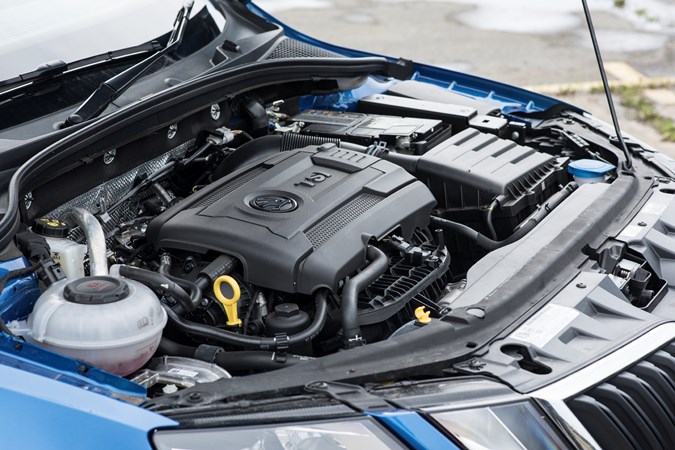
We’re driving the lower-powered manual car initially, which offers peak power between 4,700-6,200rpm and 350Nm of torque between 1,500-4,600rpm.
This version takes 6.8 seconds to crack 0-62mph – two tenths faster than the 230 DSG automatic, but a tenth slower than the hatch and two tenths slower than the 245 version. Pick the diesel and you can expect a similar run to take 8.3 seconds, although the 4x4 model is substantially faster at 7.7 seconds.
Hatch and estate offer the same economy – 149g/km and 43.5mpg – while the kerbweight of 1,367kg is only 78kg more than the five-door Golf GTI, which explains why the German car is less than half a second faster from 0-62mph.
Is it good to drive?
Yes – it’s brilliant, especially now the engine has loosened up a bit. Fast, comfortable and spacious, with subtle sporty looks and a decent standard spec.

I have a few complaints. The gearshift is quite long and doesn’t feel all that different to the standard Octavia’s, the clutch is a bit abrupt unless you put effort into shifting smoothly, and the front end loses grip when cornering at a lower limit than I was expecting.
In theory the 245hp version with a DSG automatic gearbox and mechanical limited slip differential will solve all of these problems. Trouble is, I suspect it’ll lose the value for money appeal this car has. We shall see.
Update 3: Cheap Fast Car
Octavia vRS misses out on group test crown – we explain why
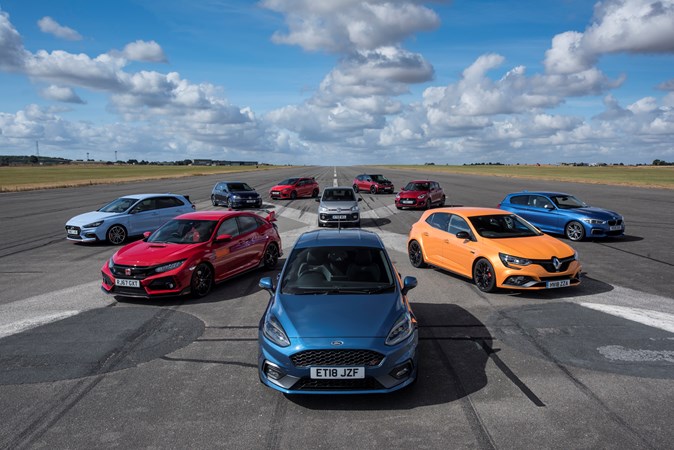
Every summer at Parkers we get all our favourite performance cars together on a track for what has become the (work) highlight of the year – the Cheap Fast Cars group test. This is proper cancel-your-plans stuff, nobody wants to miss it.
It might sound like a bit of a car enthusiast concept but you don’t have to be a petrolhead to enjoy driving a fun car, and unlike similar tests in other titles, ours has value (specifically in terms of monthly payment), rather than outright ability right at its core.
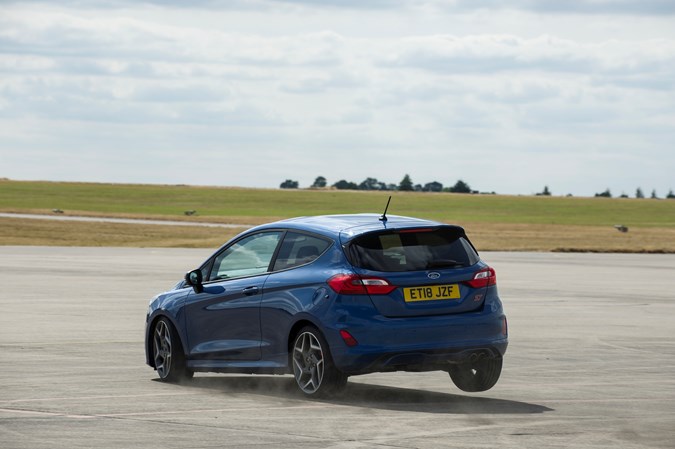
– Powerrrrr…fully good value
We’re looking for the model that gets you the most bang for your buck – something that can deliver 80% of the experience you’d get in a supercar, for 80% of the price. My maths might be a bit off there, but you get the idea.
So why wasn’t the Octavia vRS included?
Put simply, it was in our group test last year but didn’t win, and the car hasn’t changed significantly enough in that time to warrant re-evaluation this time around. It’s a strict rule but one we have to adhere to – hence why you won’t see a Peugeot 308 GTi in the line-up either – a car we rated so highly last time around we also ran one as a long termer, even though it didn’t win.
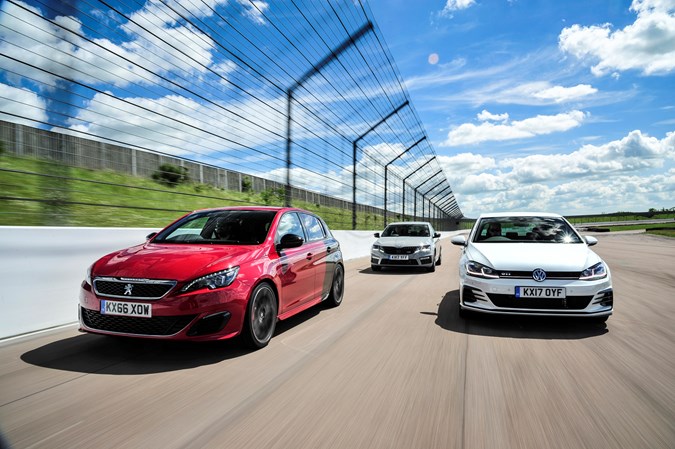
Although we all enjoyed driving 2017’s Octavia vRS it didn’t really keep pace on the track alongside the limited-slip differential-equipped 308 GTi or more polished Golf GTI, although we all agreed it was much easier to live with day-to-day.
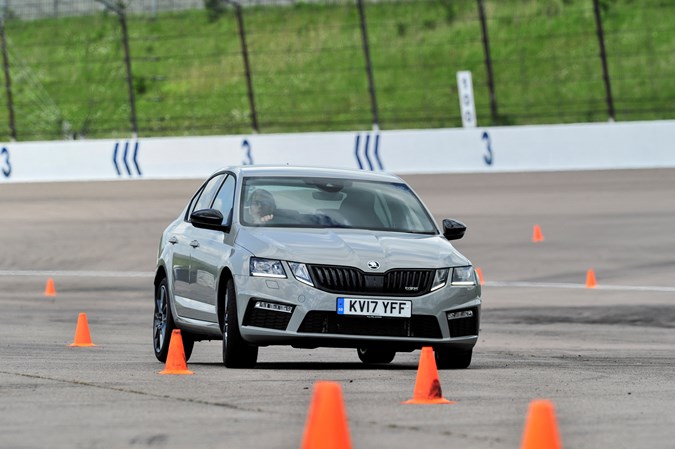
– Octavia vRS was a bit out of its comfort zone on track in 2017
So while I agreed with the decision to not consider the Skoda alongside similarly powerful but more expensive rivals like the VW Golf GTI and Hyundai i30N in this year’s test, I reckon it’s well worth your attention if you want a cheap fast car. So I managed to sneak my long termer into the group test on the basis of it acting as a support car, when really I wanted everyone to drive it and realise what they’re missing.
How cheap is it compared to those cars?
Here are the least- to most-expensive* models from this year’s test:
- VW Up GT
- Suzuki Swift Sport
- Ford Fiesta ST Performance
- Renault Megane RS
- BMW M140i
- Hyundai i30N Performance
- VW Golf GTI Performance Pack (a different version than last year, before you ask)
- Honda Civic Type R
- BMW i3 S
- Ford Focus RS Red Edition Mountune
You can’t get a finance quote for a Skoda Octavia vRS Estate at the moment because it’s not currently available to order, but at the time of the test our long termer was between the Fiesta and Megane – the fourth cheapest car here, despite being vastly bigger than those below it.
That’s impressive when you consider it offers similar performance to its arch nemesis the VW Golf GTI, the fourth most expensive car in the test.
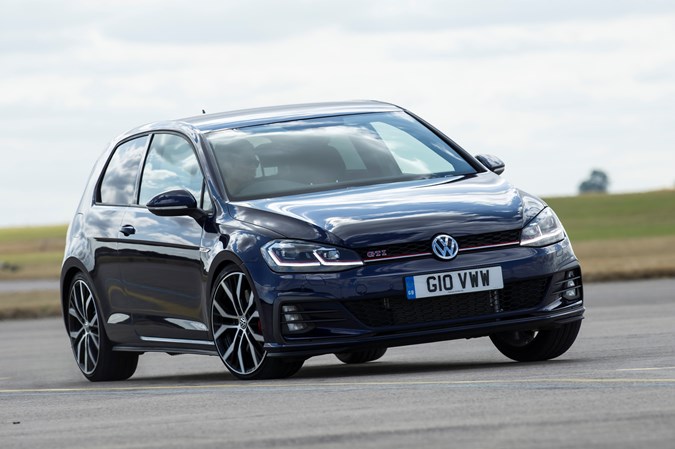
– Booooo!
The Renault Megane is always going to attract a more hardcore type of driver and is actually a bit of a bargain at the moment when you consider how many techy systems (like rear-wheel steering) it can be equipped with, but it’s still more expensive.
And while the Octavia is on par with the winning Fiesta ST in terms of cost (and performance), it doesn’t lift a rear wheel with anything like the eagerness of the Ford, despite me trying quite hard. 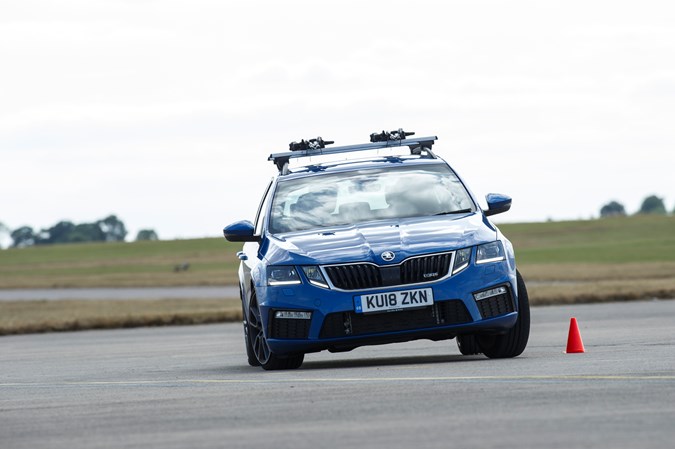
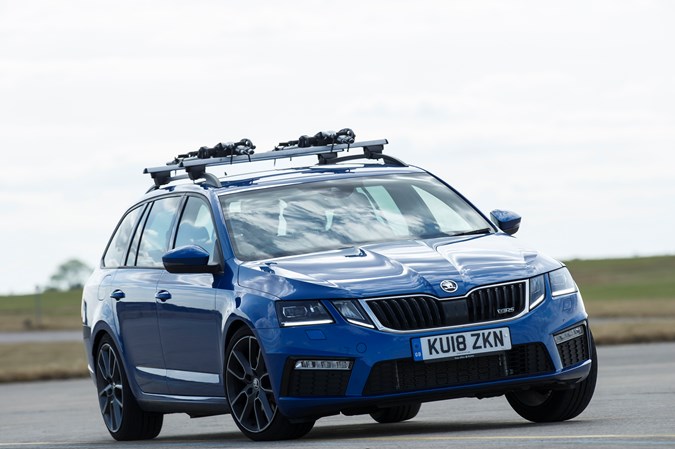
– If you squint there’s a bit of daylight there
That’s potentially because its 610 litre boot was weighed down with crisps and also, because unlike the Fiesta, this Octavia doesn’t have a diff, rock-hard suspension and short wheelbase to help it onto three wheels. Also that sort of cornering would look frankly ridiculous in an estate car.
It’s also kind of missing the point…
Yes – agreed. And while my colleagues didn’t deem the Octavia good enough for inclusion this year, they didn’t mind eating all the snacks it was able to carry, or shelter from the blazing sun under its high-lift tailgate.
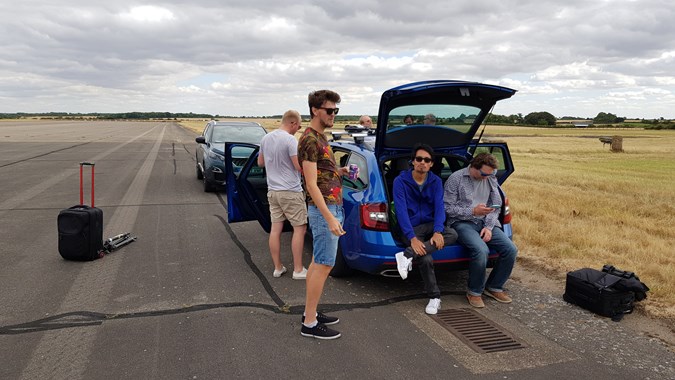
Look! They’re even at it at the Parkers New Car Awards 2019 shoot, the hypocrites. Although admittedly shade duties were delegated to a gazebo for that one.
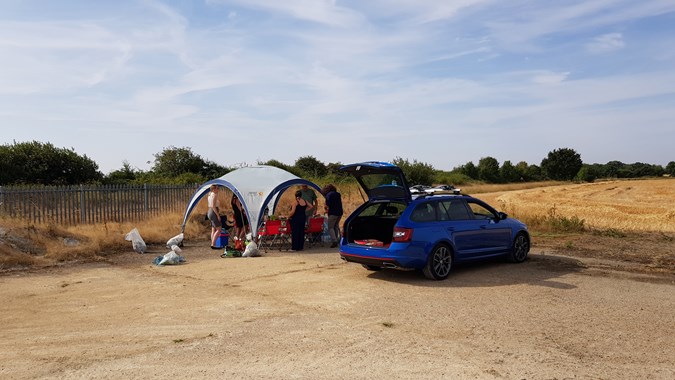
So while the Octavia might not be the most entertaining car compared with those above, if you want cheap, easy-to-live-with performance it’s the absolute go-to model. Especially the estate, which adds huge practicality into the equation too – as demonstrated here by the ability to get a massive guitar case in the boot diagonally with all the seats up.
You can’t do that in a Fiesta.
*36/37 month contracts, 10,000 miles a year, £2,500 deposit, prices correct as of August 2018
Update 4: The Thin (metallic) Blue Line
We compare our Octavia with a covert police car – and learn to drive it
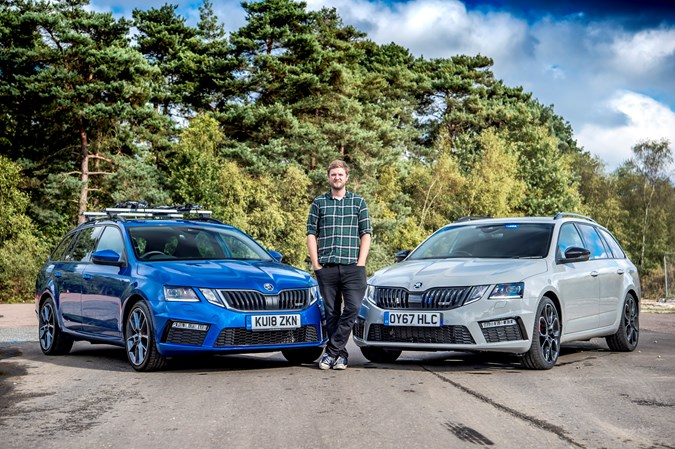
‘When you see the red and white barrier move to the right hand side of the road and get on the power, let’s see 120mph before the next corner,’ says the serving police officer to my left – the surrealness of this moment lost somewhere between the blaring siren and noise of the nearly-redlining engine.
All morning we’ve been going over the basics of ‘making progress’ – from three-stage braking, to positioning our covert police car wide for the best view around the corner, and getting back on power as soon as you see the limit point start to run. Now we’re putting it into practice at three-figure speeds.
It’s taking all my attention to drive with what I imagine is a fraction of the precision required by a properly trained police pursuit driver, and we’re on a closed test track – rather obviously, or I’d be explaining that speed to a magistrate, and not you.

Not that I’d want to be on a proper road – where I’d also have to be dealing with barked directions in one ear and radio chatter in the other, dicing with other cars reacting to my blues and twos by dithering around or braking to a complete halt in front of me, plus constantly scanning the horizon for the criminal we’re after. At 3am. After a long night shift.
How have you found yourself in this situation?
This idea stemmed from several comments from colleagues about how my under-the-radar blue Octavia vRS long-termer looks like an unmarked police car – and it’s not just us car dorks either – since it’s been mentioned I’ve noticed drivers displaying some unusual behaviour in its presence, particularly on the motorway.
On more than one occasion someone has come absolutely hammering down the lane to my right until they see me, at which point they anchor-up and tiptoe past, surreptitiously looking to see if I’m in uniform. When they realise I’m just some bloke in a Skoda, they speed off again.
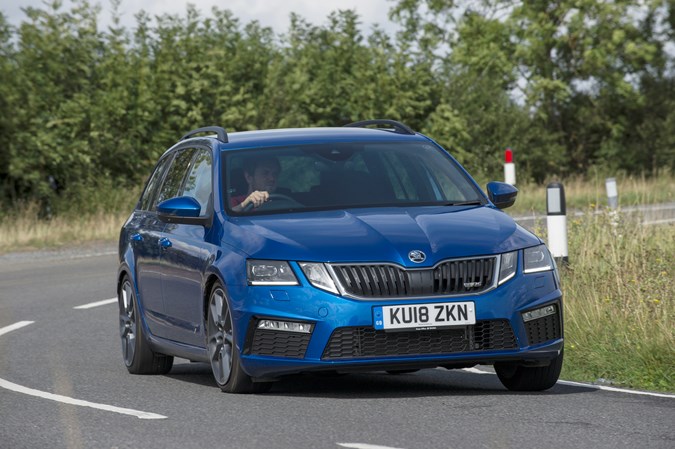
If I sit in lane one of four with my cruise control set to 70mph, before you can say ‘ello ‘ello ‘ello a lengthy peloton of cars will have built up in lane two, all trying to get around me at exactly 71mph. This, in particular, is getting quite annoying.
Undercover brother
So I thought it’d be fun to go and see a real police-spec Octavia vRS, to find out why it’s such a popular perp-seeking missile, and also get some lessons in how to drive my own long termer properly.
Luckily Skoda demos its public service vehicles a couple of times a year – where you get to drive cars converted for use by police, fire fighters and paramedics, so I invited myself along.
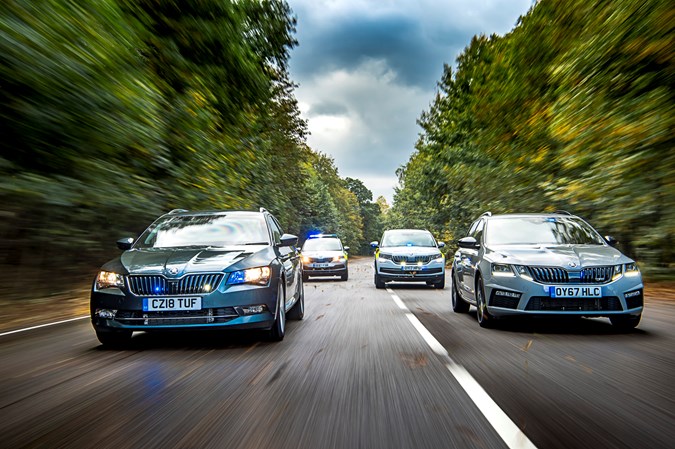
It’s held off-road at a filmset and test track in Longcross, Surrey, so even clueless civilians like me can experience the full performance of these vehicles. Oh, and drive with the nee-nors on, which let’s face it, is bucket list stuff.
Bring the noise
First things first and the keen-eyed among you will have noticed the police car has the black styling pack (you get a dark grille instead of our chrome, plus other things) and larger alloys – the latter giving away the fact this car is a vRS 245. That means it’s more powerful and surprisingly a bit lairier to look at than mine.
Other than that, the two Octavias are broadly similar, except for the flashing blue and white lights of course, which are hidden behind the grille, in the numberplate surrounds, and along the top of the windscreen and rear window.
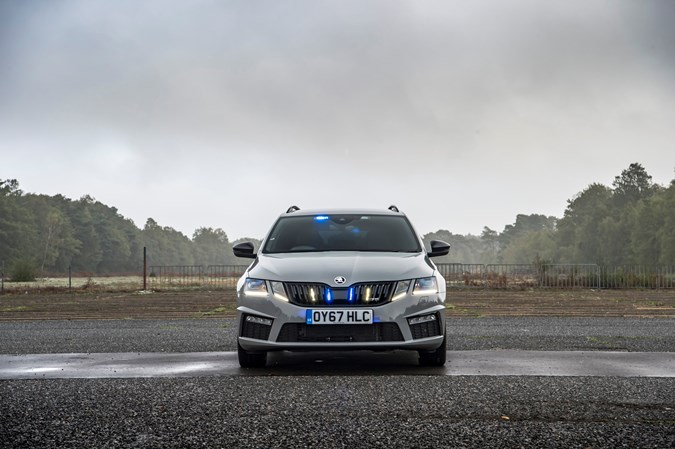
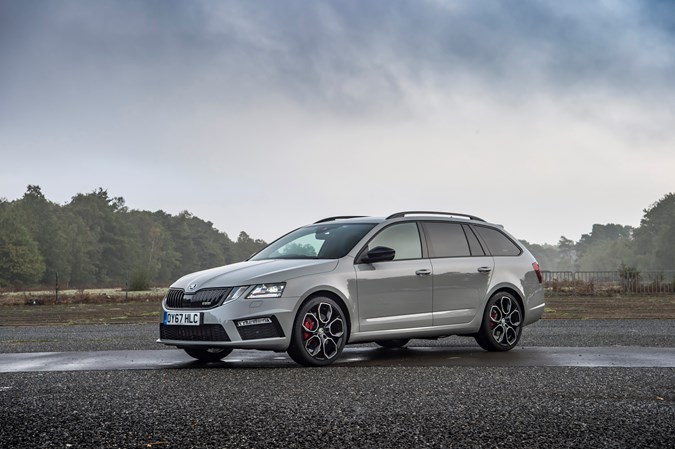
These are controlled via a panel of buttons hidden in the front cubby, while the siren is activated by pressing the wheel where the horn would normally be. One push cycles through the various tones (the drawn out one for driving a speed, the unmissable techo-tone for junctions etc) and two pushes turns it off.
Firing up the roof while driving at speed is immensely satisfying – plus a lot louder and more distracting than I was expecting. It suddenly makes everything seem very serious indeed. Real traffic police get a substantial amount of training in order to do this stuff for real, even adopting a unique system of car control, which is quite unlike anything else I’ve ever experienced behind the wheel.
Roadcraft
First we did a couple of laps using what you’d consider a normal ’racing line’, starting out wide, moving towards the apex, and then back out again under power. Then we took the ‘police line’, which in essence involved getting right onto the outside for much longer, to enable good vision and more time to react to any hazards.
Assessing how fast a corner should be taken is done by limit point analysis – working out how far ahead you can see and adapting your speed accordingly. Sounds basic, but let me elaborate.
In fact you can try this yourself – look all the way down the road until you can’t see any further, due to a bend in the road or a blind summit, etc – this is the limit point. If it’s ‘static’, meaning you cannot see any further around the corner even as you approach it, you need to slow down and be prepared to stop.
If it’s ‘matched’, then you’ll be able to see more and more of the road ahead as you move towards the corner, and this means you need to maintain your speed. Finally when the road opens out ahead of you faster than you can catch it up then the limit point is ‘running’, and you can get your toe down.
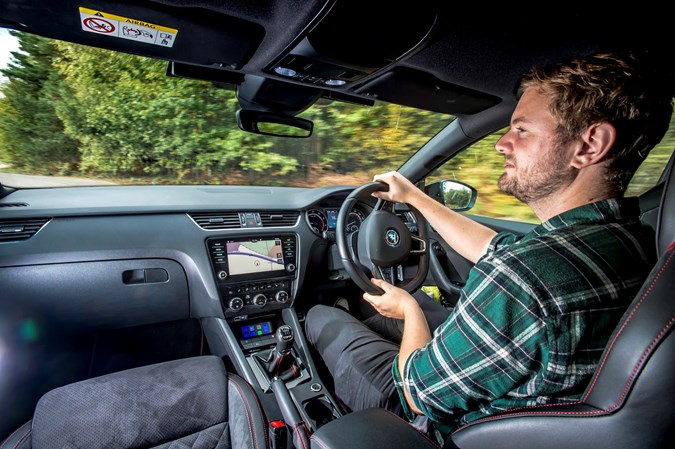
Braking is taken care of using a more formalised version of how I’ve been shown to drive on track, actually, which is to take up the slack in the pedal before pushing it into the carpet, and then feathering back off. This ensures maximum braking force while avoiding any harsh movements that could unsettle the car.
That’s all well and good in a calm and quiet car but with the full suite of lights and noise activated my heart rate went through the roof – the siren makes everything seem more urgent, every decision more life and death, even on our closed circuit.
It’s terrifying and, to be honest, exhilarating. I can’t imagine what responding to a genuine emergency must feel like, knowing any seconds wasted taking a corner wrong could mean the difference between getting to that person who needs your help, or not.
What’s the Octavia like as a police car?
Great – for all the same reasons it makes a good family car. There’s loads of room in the back for coppers or child seats, the boot is massive and can take all their equipment, it’s really comfortable on a long shift (as a PC or a parent) and can really get a move on when necessary.
It’s such an untaxing thing, the Octavia, whether you’re going to the 36th toddler’s birthday party of the year or trying to get the highest speed of the day on the back straight of a racetrack (125mph in case any of you are reading).
I only wish my own car had a bank of flashing lights and sirens. I know it sounds like I’m making fun of what is a very serious and important job, and believe me I have a new-found respect for anyone who can drive that fast, with the stakes so high, while concentrating on so many other things. But man, what a rush.
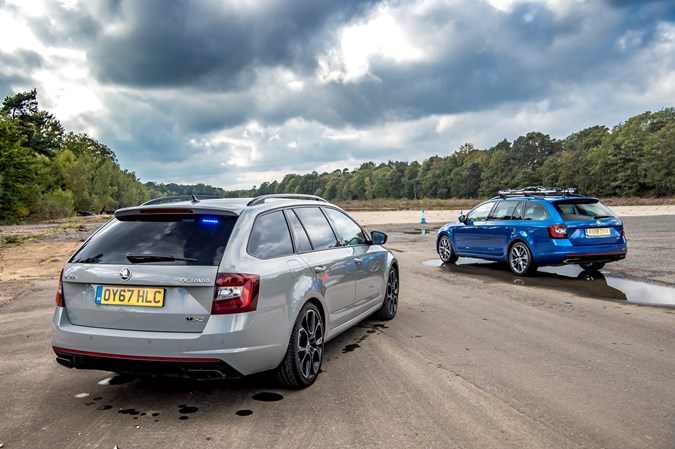
Update 5: Off to Cornwall
We drive to the coast in the Octavia to see what it’s like on a long run
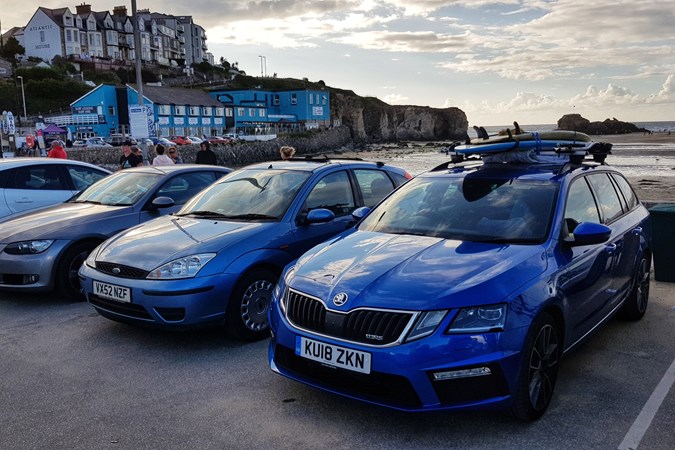
One-by-one my friends have emigrated to Cornwall. Having spent many holidays there camping together as teenagers, it seems our initially pie-in-the-sky-dreams to eventually take up permanent residence in the British deep south are finally coming to fruition, now as 30-somethings with kids, fed up with sky-high living costs radiating out from the capital.
I say we, I’ve got no plans to move at the moment, and on the one hand this is a bit of a bummer – but in order to stop this long-term update turning into some sort of one-way therapy session from my landlocked Peterborough office, let’s find the silver lining – at least it means free holidays for me and my growing family. Plus a good excuse to test the long distance comfort of my long termer.
The best bit of all is that one of my closest friends has loads of space in his shed (obviously) for my long-suffering surfboard, which until now has been cooped up in my garage, dreaming of the punchy autumn swells it used to enjoy when I was a student in the south-west.
How much space is there in the Octavia?
As you’ll no doubt be aware from the last couple of updates, I’ve got a brilliant Skoda-branded roof rack that I have been putting to good use almost every weekend, carrying my mountain bike so I can search out the sort of twisty singletrack I’ve come to rely on as my only form of exercise.
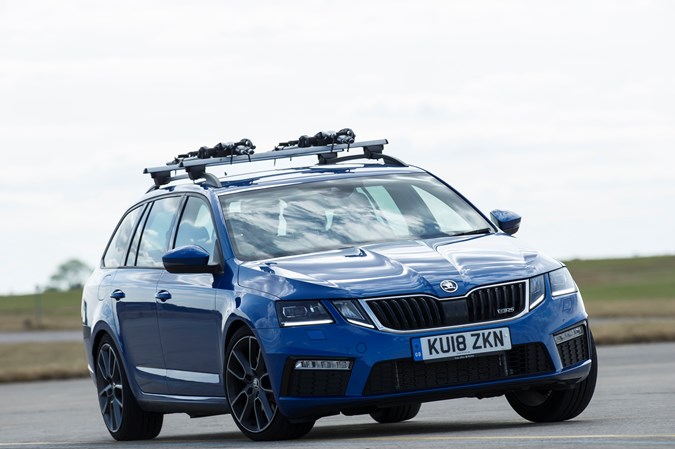
For this adventure, however, the Octavia would need to serve multiple purposes – carrying my wife and I, my bike and surfboard, as well as two small passengers and the cavalcade of equipment that goes along with them.
That might sound like a fairly regular set of expectations for a car but when you break it down it becomes more complex. A journey of several hundred miles requires a comfy ride twinned with an engine powerful enough to dispatch overtaking manoeuvres and short slip roads with ease without requiring a tank of petrol every hour.
In terms of space there needs to be a long enough wheelbase to enable the front passenger to recline without impeding on the either child’s massive Isofix, but the car still needs to fit into a standard parking space.
On top of all of this, the boot needs to be capacious enough to swallow all our stuff without spilling onto the back seats, and the roof bars need to be wide enough apart to fit a big surfboard and mountain bike.
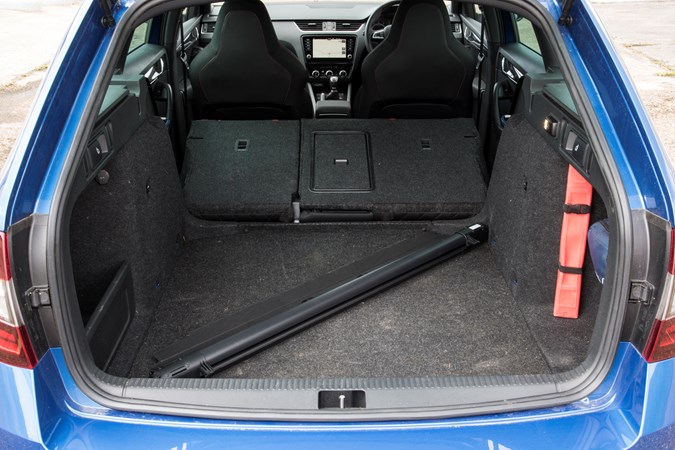
In short, if you designed a vehicle by committee with these exacting criteria in mind you’d end up with either a camel or the domed monstrosity Homer Simpson penned, which ultimately sank his brother’s automotive business.
Or, a Skoda Octavia vRS Estate.
What are the seats and suspension like on a long run?
Aside from the above dimensions, the fact Skoda has pitched the standard suspension set up in the vRS right down the middle of sporty and cosseting makes for sublimely wafty motorway travel. It’s firm enough to resist wallowing (and the back-seat vomit that inevitably follows) while still compliant enough to iron out any lumpy expansion joints or cracked tarmac. Standard-fit lane-keep assist takes a bit of the work out of keeping the car between the lines too.
I also don’t want to be wringing every last RPM out of a car to make decent progress when my family are on board because they rapidly get fed up with the noise (particularly if it wakes someone up) so the fact the vRS has so much mid-range punch means you can short-shift it and ride the wave of turbocharged torque and the quiet end of the rev range.
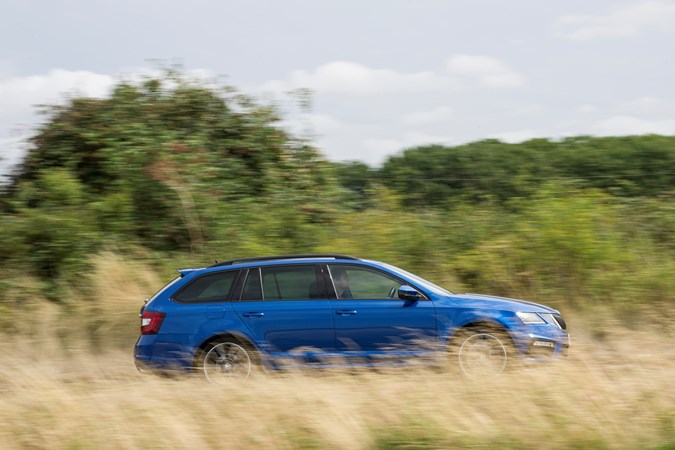
The seats are fabulous too – often sporty looking buckets are great at pinning you in during a series of corners but thin on padding and too stiff on a long drive. Not so in the Octavia – the side bolsters are supportive enough but also nicely cushioned, as is the base, so you don’t get a numb behind.
If I’m being really picky I might suggest the manual gearbox is a bit tiresome on a run, especially the springy clutch in stop start traffic. That’s not a problem particular to the Octavia, but I reckon the DSG would make life even easier still – we’ll find out when we swap into one in a couple of months’ time.
Is the Octavia any good as a surf wagon?
Getting two boards onto the roof (one for me, one for my friend) proved easy thanks to the Octavia’s lowered ride height – you really don’t have to stretch to lift and secure them with a couple of straps.
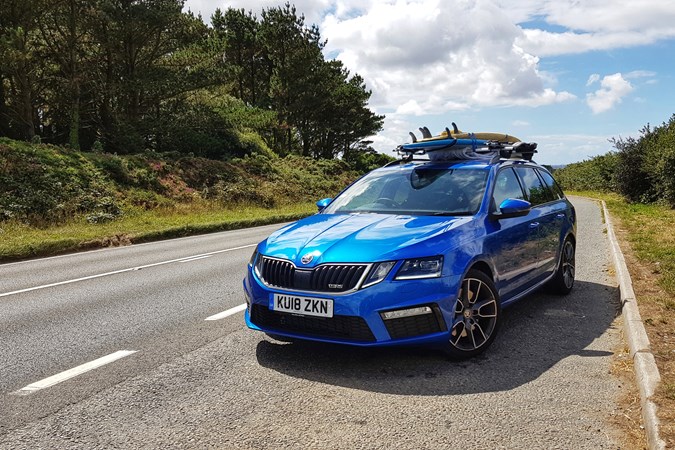
The massive boot (now empty of all my family’s luggage) swallowed two big tubs to store wet wetsuits and even provided a small amount of privacy to get changed in before we got in the sea.
Then when a couple of the other guys asked for a lift up the hill, we all fitted comfortably thanks to the extended wheelbase and the additional leg room that provides. I reckon a diesel 4x4 Octavia (either Scout or vRS) would be an even better surf wagon though – not that all-wheel drive is strictly necessary but it’s a nice thing to have when you’re negotiating an untarmacked, sandy car park.
 The Parkers Verdict
The Parkers Verdict
Yet another task the Octavia vRS Estate has ably adapted to. Best of all, it somehow manages to bend time and make an all-day drive home seem substantially shorter, so the normally arduous job of leaving everyone behind was that little bit easier.
By Adam Binnie
Update 6: Video review
We examine the Skoda Octavia vRS Estate under the Parkers’ video microscope

Because I think our long term Skoda Octavia vRS Estate is just about the best all-rounder you can buy today (and also, because according to my colleague Keith Jones, I am a massive attention seeker) I decided to examine the blue wagon’s credentials via the lens of our extremely talented videographer Matt Vosper.
There’s certainly something to be gained by seeing the car cornering and hearing the engine that I can’t convey completely in words, and also we manage to find something large enough to fully demonstrate the load-carrying ability of this large-booted Skoda.
Is this video worth watching?
Yes! Although rather strangely the 230hp version of the vRS is now off sale, replaced by the more powerful 245hp car (which I wrongly call a 240 at one point in the video, largely because it was boiling hot and I wasn’t allowed the air conditioning on in case it interfered with the sound) but the advice here is still relevant if you’re looking at a nearly new model.
Other highlights include a short sequence where we stash £20 worth of crisps in various cubby holes and when I almost do my back in trying to lift a tumble drier out of the boot.
Update 7: Big Bike Update
We’ve seen how well the Octavia copes with surfboards, but is it any good at transporting bikes?
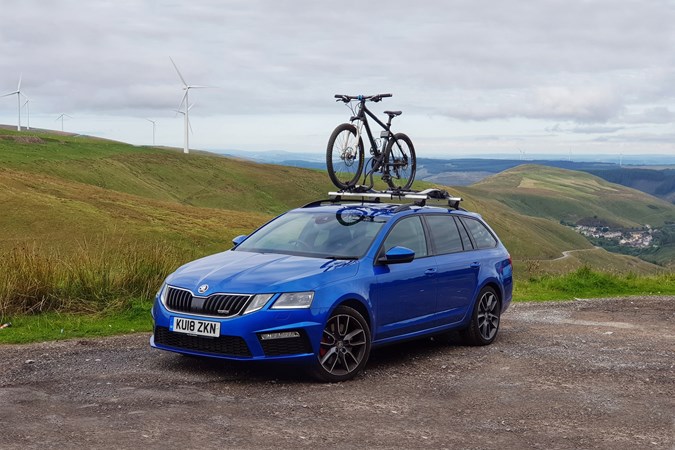
Most of us ask our cars to fulfil many different and wide-ranging tasks – in an ideal world I’d like mine to be comfortable and spacious for weekend family use, with a decent turn of pace for my weekday commute, and the ability to transport two or more bikes when needed, too.
I’ve said before that I think the Skoda Octavia vRS Estate has the first two points neatly sewn up in a good value package, but how well does it cope with the third? Can we crown our long-termer the ultimate cycle support vehicle?
Well, in order to find out I spent most of 2018 hitching mountain bikes to the roof and searching out new trails, and even went to spy on the Skodas used by skinny-tyred roadies at the Tour of Britain cycle race.
What makes a good cycle support vehicle?
Everyone’s different but I reckon the core values of a low roof, a large boot and comfortable seats are universally useful.

It’s likely you’ll be heaving your bike onto the roof unless you’ve got a towbar-mounted bike rack, but these are expensive and add length to what is already quite a long car. Getting something heavy to that height means the closer it is to the ground the better, unless you can find a handy step like my colleague Chris here.

For those times when you need to lock your bike away somewhere safe it’s handy to know it’ll fit easily in the boot – my hardtail with its 26-inch wheels goes in easily – after you collapse the rear seats using the remote handles in the boot.
A handy storage box on the left keeps tools and lube from rattling around and four foldaway hooks can be used to secure a helmet and also to keep my leaky Camelbak upright so it doesn’t spill water everywhere. I suppose I could just buy a new one, but that’s not the point.
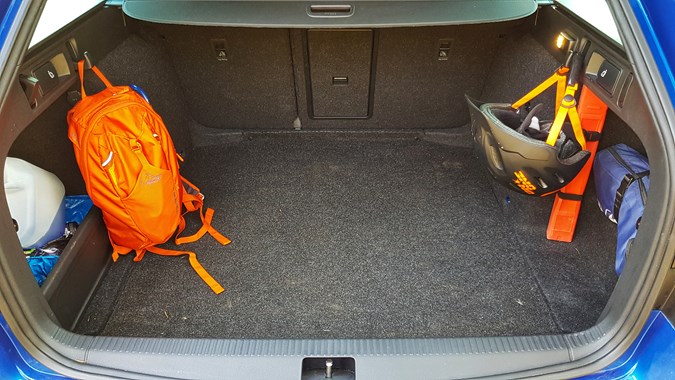
Inside, the supportive but squashy seats are super comfy and heated too, which is great after a long ride, and the surprisingly good stereo is perfect for my chosen weekend stress-buster of pedalling quite fast down a muddy hill and then driving home listening to very loud heavy metal.
The Octavia isn’t perfect though – the optional Canton stereo in our Kodiaq had much better bass, and my larger full suspension bike with its 27.5-inch wheels requires a bit of disassembly before it’ll go in the boot. Plus, the car’s sporty lowered suspension means the vRS Estate doesn’t have the greatest ground clearance for getting around lumpy car parks. An Octavia Scout would be better in this respect.

Where the Scout would fall short though is in terms of enjoyment on the road, where the vRS is an absolute blast. Granted you can’t go flat-out with a bike on the roof but its powerful engine and tight handling makes the drive home from a bike ride an event in itself, especially on the kind of wiggly roads that lead to my favourite spot in south Wales, which is also where this update is heading.
Wales?
Yes – towards the end of 2018 we made a pilgrimage to Camarthenshire to watch one of the mountain stages of the Tour of Britain and also to do some pedalling of our own, although road cycling is a very different discipline to the muddy version I prefer and requires a very different skillset and physical build (read: much thinner).
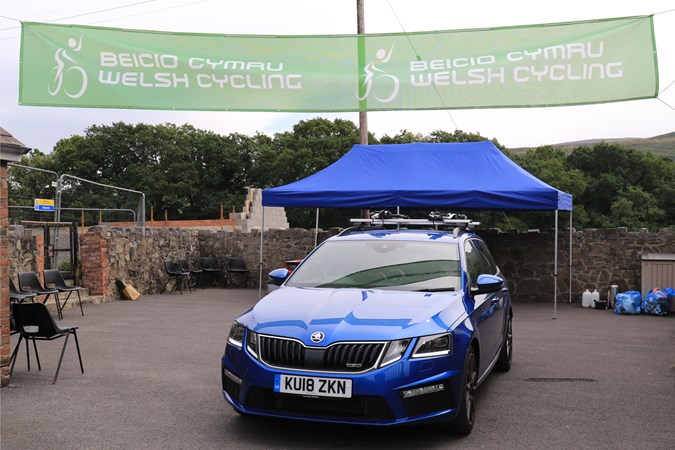
We watch hours of cycling on television in our house – the three grand tours plus the UCI Downhill World Championships and whatever else we can get our hands on.
Support for bike racing seems to be growing steadily, helped by big UK names like Wiggins, Froome and Thomas, plus our now almost-guaranteed success at the Olympics. That means events like the Tour of Britain are well-attended, and as a result have a fantastic atmosphere that you can’t experience from your living room.
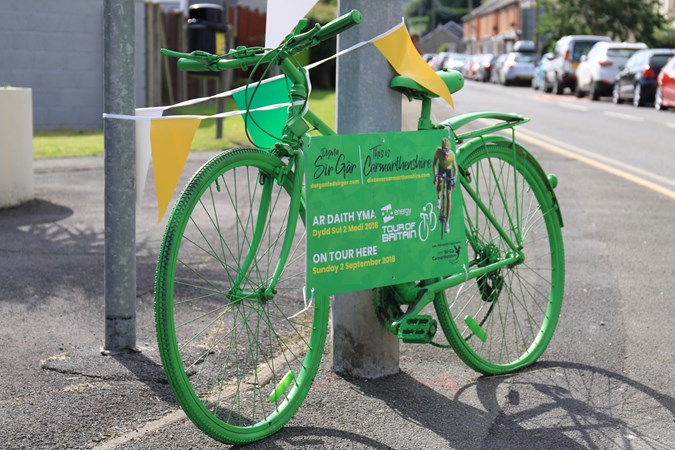
I’ve always wanted to go to a Tour de France stage but given that you only seen the bikes for about 30 seconds, and having a young family, it’s always been too hard to justify making the trip.
So getting into the Welsh hills to see some of our favourite riders – including winner of the 2018 Tour de France and local hero Geraint Thomas – rush past, seemed like an ideal replacement.
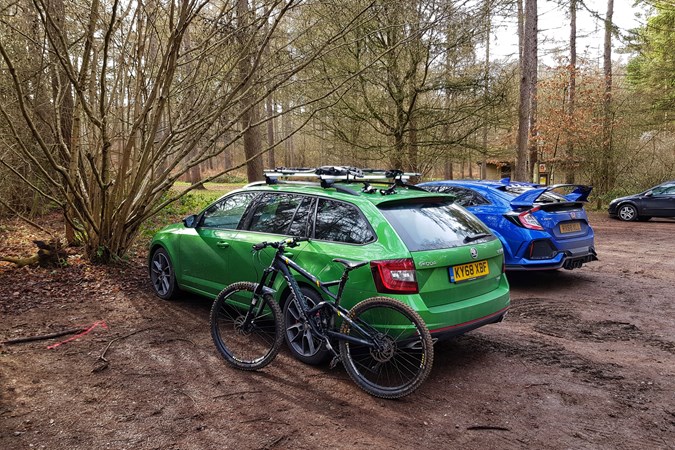
I was also keen to get a good look at all the team cars – almost exclusively Skodas (perhaps unsurprisingly given the manufacturer sponsors the event), including Karoqs, Kodiaqs, Octavias and Superbs – as you can see in the slideshow below.
Most teams seem to favour the more spacious Superb these days. It’s a handsome car but there’s just something about a team livery and aero roof rack that takes it to another level.
There was one exception of course and that was the Team Sky Ford Ranger, which looked absolutely epic in its white and blue livery, and added weight to my argument that Gareth should get a tailgate pad for his Amarok and spend his weekends driving me and my bike to the top of my favourite downhill run to save me pedalling.
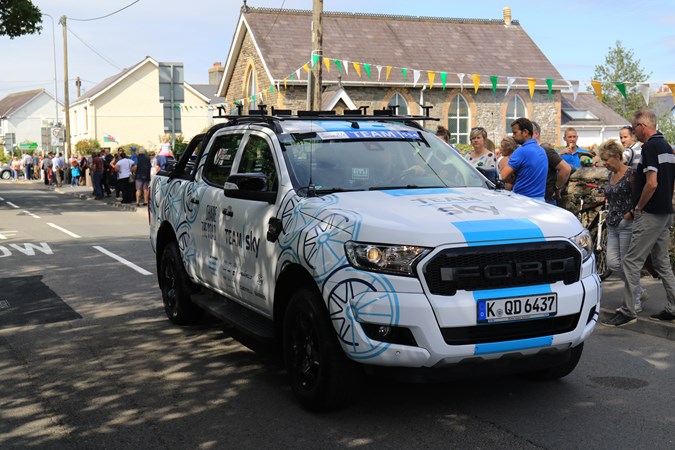
Best of all was the Team Wiggins Octavia vRS – just like ‘mine’, except for some reason they’re still rolling around in a pre-facelift car. Sort it out Brad.

I’m a big fan of that livery though, I wonder whether we could get our long termer wrapped?
Time to leave the tarmac
While in Wales it seemed rude to not visit my favourite bike centre called Afan, and take in some of its speedy blue runs. Mountain bike trails are graded like ski slopes – from easy green and blue to tricky red and expert black. Each section has its own name and as you can see, even the more mellow runs come with scary titles.
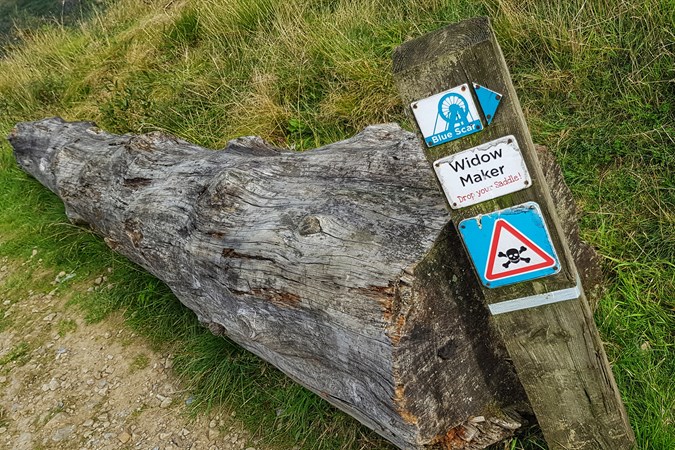
This south Wales bike park features (and is perhaps more famous for) its excellently technical, pedally red routes with lots of roots and rocks to test a long travel trail bike. I’ve huffed and puffed round these on my big bike before and to be honest, didn’t fancy doing it again under the beating sun.
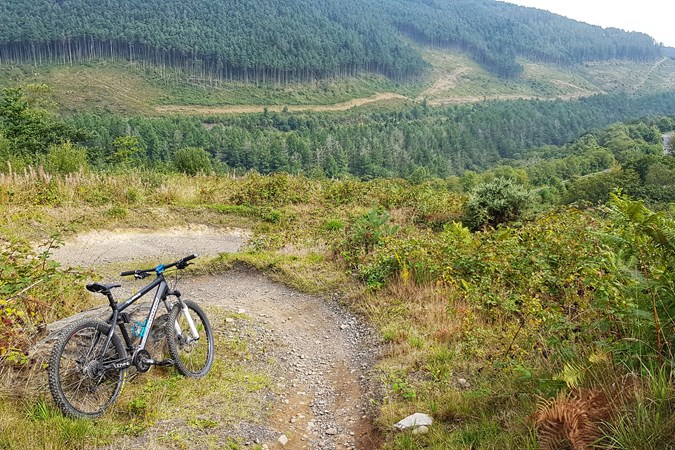
Much more tempting was putting some low-rolling resistance tyres on my hardtail and making the most of the smooth but steep Blue Scar trail, which would be running super-fast after a long, hot summer. There’s a bit of climbing to do before you can enjoy the gravity-powered descent but it’s easy going on a light and stiff bike like this.
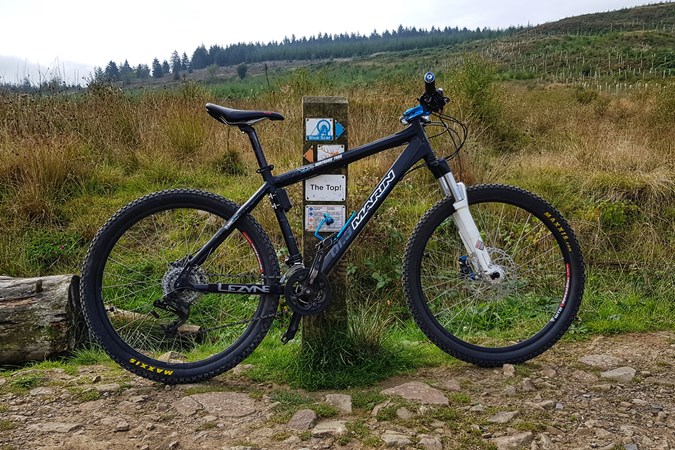
As well as making the odd big trip to Wales I also spent what felt like every weekend a bit closer to Peterborough, at a woodland red trail near Woburn, which as you can see from this picture, isn’t quite as smooth.
I probably should have taken my full suspension bike in this instance, as the hard-packed mud, roots, and my heavy riding style nearly smashed my Marin’s back wheel to bits. Oops.

What’s the point of all this bike chat? Well, what I’m trying to say is that I spent an enormous amount of time on two wheels in 2018, largely because the Octavia makes it so easy. It’s a total enabler – if you’re after a car to make indulging in your hobby as easy as possible then look no further.
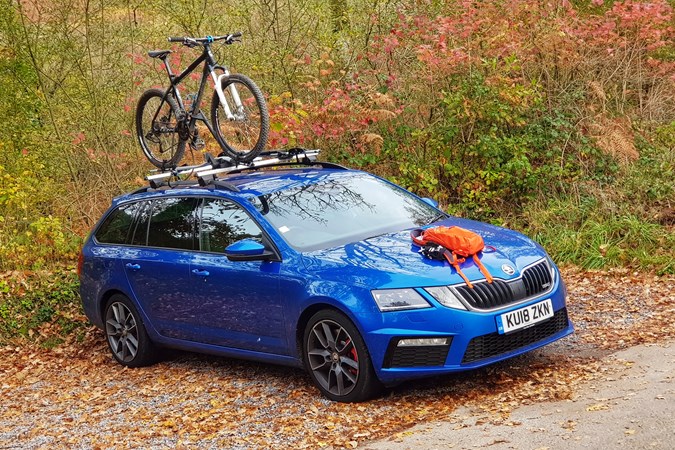
This is how our blue car spent most of its summer – with a boot full of muddy jerseys and flapjacks and a bike on top, heading to a muddy hill somewhere. I even started sneaking rides into my lunchbreak, because lobbing my bike on the car in the morning took seconds, and meant I could go for a midday shred.
How easy is the Skoda Octavia roofrack to fit?
As I mentioned earlier I’ve barely removed it – every time I think about taking it off I realise I’ve got another ride planned in a day or two, so I’ve pretty much just left it on the car. The wind noise and fuel economy penalties are so minimal, so why bother?
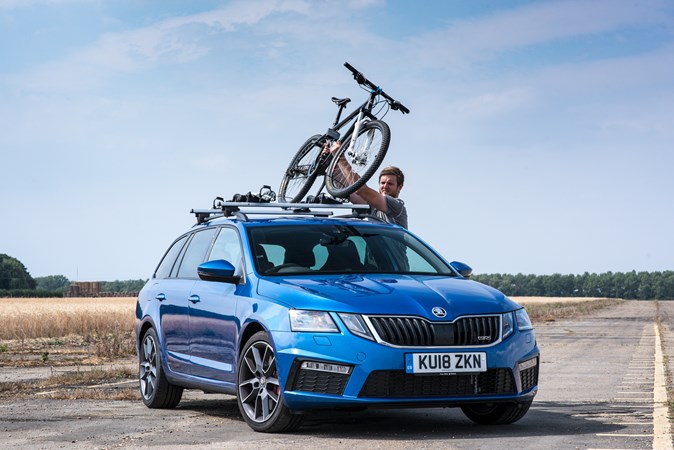
Getting a bike or two on the roof is simple thanks to the Skoda-branded-but-Thule-manufactured carriers. The front and rear wheels are held in place with plastic tie-down ratchets, while an upright support clamps onto the frame and can be locked in place with a key. I’ve also taken to attaching a lock around the bike and roof rail for extra security.
When you do need to remove the rack it’s very easy. There are four locked covers to remove and then four levers to loosen, before the entire outfit comes off in one go to be stored in the garage.
So to answer the earlier question, the Octavia vRS Estate is just about as good as it gets if you’re a cyclist. A bit more ground clearance would be nice in some circumstances but for all other intents and purposes it’s slotted into my life like a well-oiled gearchange.
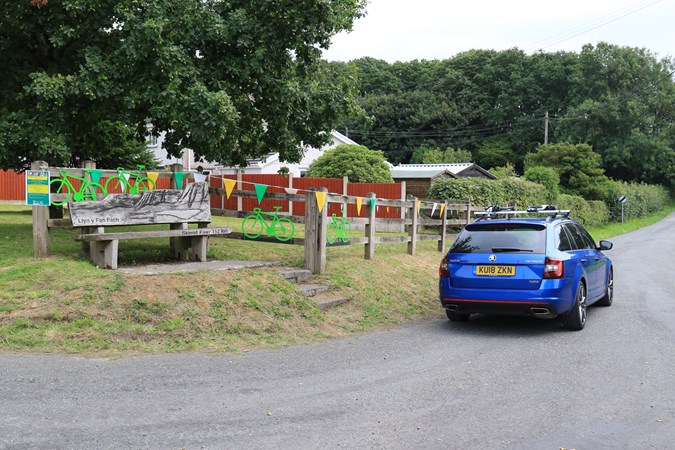
Update 8: Goodbye blue car, hello green
Time’s up for our blue Octavia vRS 230 – we’re swapping into a more powerful version

We’ve come to the end of our four glorious months in this Skoda Octavia vRS 230 Estate and regular readers will know that means it’s time to swap into the green vRS 245 pictured above.
It’s fair to say it has got so far under my skin that I considered calling the whole thing off and asking whether I could just buy the blue car. It’s perhaps telling that the only other long-termer I’ve run at Parkers that has had this effect on me was an Audi A4 Avant with a torque-monster of a V6 diesel engine in it. Clearly fast estates are just my thing.
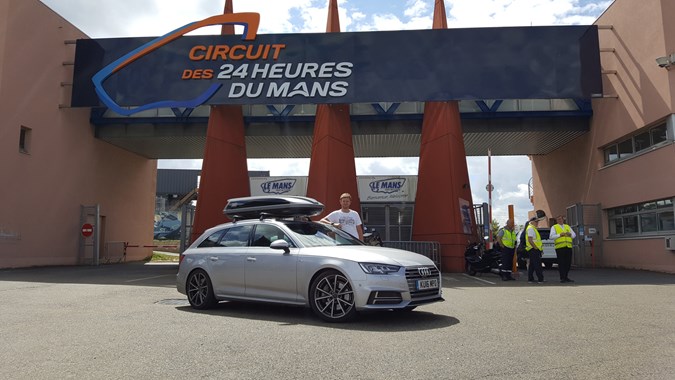
I really enjoyed that car but I’ve preferred the Skoda – not least because the German was a bit showy and people seem reluctant to let you out of side turnings when you’ve got four rings on your grille. The Skoda is an undeniably cool thing but it’s totally classless and in standard blue paint is pleasingly anonymous on the road.
That sounds like false praise but while I’ve always liked the exciting, heart-on-your-sleeve looks of hot hatches like the Honda Civic Type R – you know what you’re getting with a big wing and bonnet scoop – constantly having to deal with other motorists wanting a race all the time gets really boring, which is where the Octavia’s subtle looks came into their own. Subtle isn’t really my middle name, so I was really surprised how much the Skoda’s styling won me over.
Big power, big boot
The two most obvious strengths of this car are the 230hp under the bonnet and the 630 litres in the boot – more than enough at either end to ensure this Octavia is best grown-up boy racer’s family car this side of an Audi RS 6. Oh, and it costs half as much.
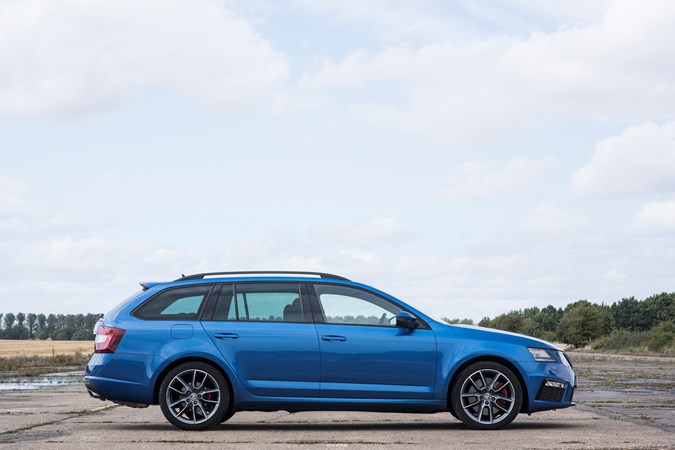
I loved the easy-going nature of its power delivery – you could either drop a gear and wind the 2.0-litre turbocharged motor up or simply leave it alone, stand on the gas pedal and wait for the acceleration. This made it feel pleasingly old school, like a Subaru Impreza, and the boosty midrange gave it a stronger sensation of speed than the numbers suggested.
In terms of handling the Octavia didn’t feel quite as sharp as the Golf GTI and didn’t exactly major on front end grip, particularly in the wet when it would plough on quite happily. It was certainly tidy enough in the dry if you bore in mind its relatively unsophisticated set up – you only get a limited-slip differential in the more expensive vRS 245 – so tread carefully.
Anyway, more impressive than its outright agility was how the chassis managed to be both sporty and supremely comfortable in equal measure. It’s high praise indeed to say that at times you could forget you were in a vRS at all, such was the comfort of the suspension. I think this quality is lost is most modern hot hatches – even the Golf GTI to some extent – which all seem more focused on cornering ability than how easy they are to live with. The Octavia vRS scores top marks here.
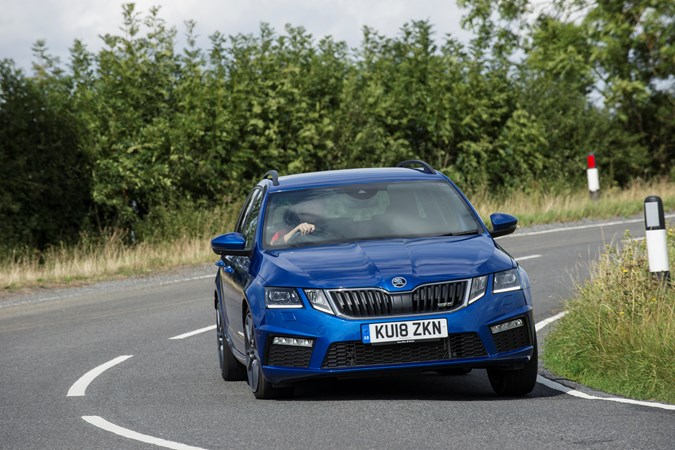
My criticism of the motor’s rather flat engine note (particularly from the outside, where it doesn’t sound very sporty at all) was also a benefit when it came to weekend driving, when I was most likely pottering about with my family on board, in no particular rush. This, in combination with the comfy ride, made the Octavia a car we could all enjoy. Not just me.
Then there were times when I’d have to, ahem, make good progress with passengers in the car. The majority of the burly engine sound you get in Sport mode comes through the speakers, so it was easy enough to calibrate the individual setting to give me maximum power with minimal noise. Smooth and wafty speed was easy to attain.
Talented and likeable, but not perfect
For the sake of balance I made quite a few notes about things in the vRS that bugged me, not least the bits that felt like they’d come straight out of a standard Octavia – namely the gearstick (too long) and the clutch pedal (too springy and it’s biting point too imprecise).
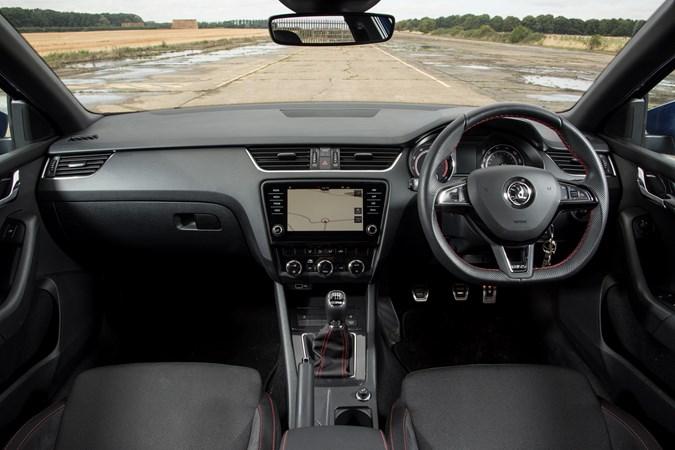
The latter did eventually get easier to live with, either it loosened up a bit or I just got used to it, but it certainly made smooth shifts a tricky process, especially when going quickly, because you were never really sure where the bite point was. I discovered the best way to change gears in the Octavia was to abandon all attempt at clutch pedal finesse and basically dump it between shifts. Not ideal treatment for the drivetrain, so I didn’t make a habit of it.
Other gripes include the thick pillar between front and rear doors, which creates blindspots, especially when combined with the padding of the passenger’s headrest, which always seemed to be in the wrong place. In the back I couldn’t work out how to remove the rear headrests, which made fitting my son’s high-backed booster seat a bit awkward, too.
The non-powered bootlid is also heavy to shut – primarily because it’s a massive tailgate and opens really high, so it needs particularly muscular gas struts. The bluff back end means big bootspace but also creates some aerodynamic oddities – give the Octavia a big shoe of gas and exhaust fumes cloud up the outside of the glass. On a cold morning you’d need the help of the rear wiper to retain visibility out back. Which I actually found quite satisfying.
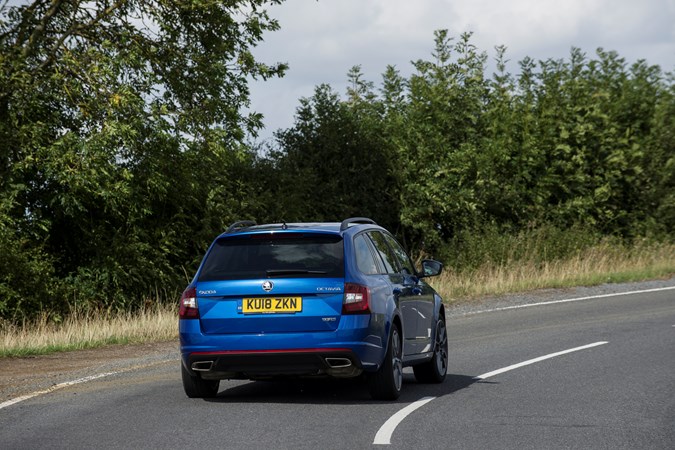
Fuel economy was a bit of a sticky point too – it wasn’t bad overall – I got an average of 33mpg over my not-quite-10,000 miles, which included a lot of motorway miles, plus time spent with a bike on the roof, and some erm, spirited driving too. It could be quite inconsistent though – tanks ranged between 38mpg and a rather alarming 25mpg – although that was when we were filming our review video, requiring a fair bit of to-ing a fro-ing. I got an average of 300 miles to a tank, which meant filling up quite a lot, and spent a total of £1,722 on fuel during our time.
While we’re on fluids, at about 8,000 miles the Octavia told me it had boiled away most of its coolant – a technician at a nearby Skoda garage suggested these engines tend to run quite hot – so it’s worth casting an eye under the bonnet every now and again.
Really though, I’ve got very few complaints – if you’re in the market for a fast family car there’s really nothing quite as complete as a Skoda Octavia vRS, which is especially impressive when you consider how good value it is.
Why spend more money on one, then?
Therein lies the perfect set up to the question we asked at the beginning of this test – just how much Octavia do you need? Well, in order to answer that we need to say goodbye to this optionless, 230hp manual car and spend some time in an automatic, 245hp model with loads of extras (you can read about that below).
My prediction? I love the brilliant simplicity and value of the standard car, especially in underdog, is-that-a-police-car blue. That said, I think the green car’s limited-slip differential will transform the handling, and the automatic gearbox will remove any issues around the springy clutch and workaday gearshift. Plus a powered boot and keyless entry will make it considerably less work to live with. See? It’s quite easy to get carried away
In fact the prescence of a green replacement is the only thing making the departure of the blue car acceptable, otherwise I think I’d be very upset indeed.
What a joy this thing has been.

| Skoda Octavia vRS running costs |
|
| Total mileage | 9,557 |
| Real-world average fuel economy | 33mpg, 76% of official |
| Official combined fuel economy | 43.5mpg |
| Joined Parkers fleet | 1 July 2018 |
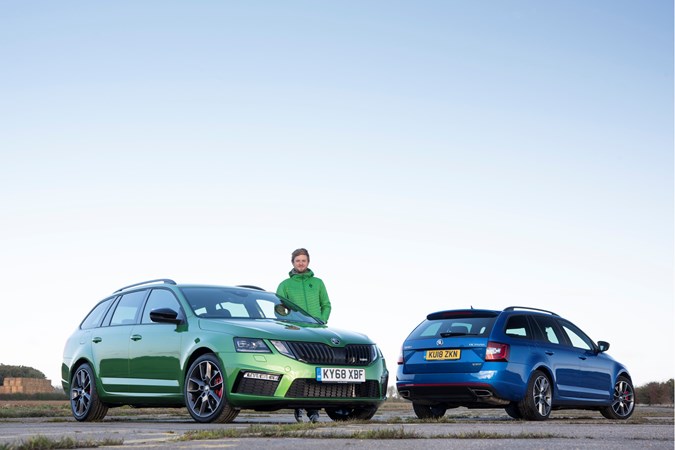
Update 1: Welcome and spec
Since before I can remember I’ve always associated fast Skodas with violent, migraine inducing green paint – whether on the calipers of a mythical onyx black covert police hatchback or the body panels of the venomous looking estate in front of you.
There’s something a bit sensible-car-gone-bad about the Octavia vRS as it is, in the same vein as a fast Volvo, and that’s made all the more exciting by a shade of paint that wouldn’t look out of place on a Lamborghini.
So when it came to speccing up this car – which is the opposite end of the options spectrum as the everything-standard blue car it replaces, I decided to pick some paint that put it equally far away in the visual spectrum, too.
And doesn’t it look striking? That’s the combination of the lurid paint job and the darker exterior trim pieces – the chrome of the old car is gone, replaced by piano black plastic and tinted rear windows.

While our blue Octavia had something of a stealthy silhouette which meant from a distance you couldn’t be sure if it was a vRS or a 150hp diesel, there’s no mistaking the intent of this model.
And that’s reflected in a suitably more purposeful drivetrain – 245hp, with a limited slip differential and DSG automatic gearbox to help put that power down.
Thing is though, I configured this car before I’d even driven the blue one, assuming more power and sophistication in the drivetrain would be an obvious improvement, and along with a more exciting paintjob.
As time went on in the blue car, though, I came to appreciate its subtle looks and incredible value – it’s a fast car for people who don’t want everyone to know they drive a fast car. I’m starting to wonder whether you kind of ruin that vibe by making it eyesore green
Whether or not the colour was a good choice will come to light over these updates – it’s already dividing opinion in the office. For now I think it’s absolutely excellent.
Update 2: Performance and handling

During the first week of January when the car launch calendar was quiet, a bunch of us from the Parkers team went to north Wales in our long termers for a bit of an adventure.
We did something similar last year (although that time to the North York Moors), and found the whole experience very rewarding – not only for the opportunity to carry out some spirited driving in each others’ cars in scenic and unfamiliar roads, but also to test how they fared on a boring motorway slog too. A solid all-round test.
What cars did you take?
Including my Skoda Octavia vRS Estate, we took Lawrence’s Peugeot 308 GTi, Chris’s BMW M140i, Richard’s Mitsubishi Eclipse, Gareth’s VW Amarok, Stuart’s Vauxhall Grandland X, Tom’s Cupra Ateca, Keith’s Volvo S90 and James’s Ford Focus.
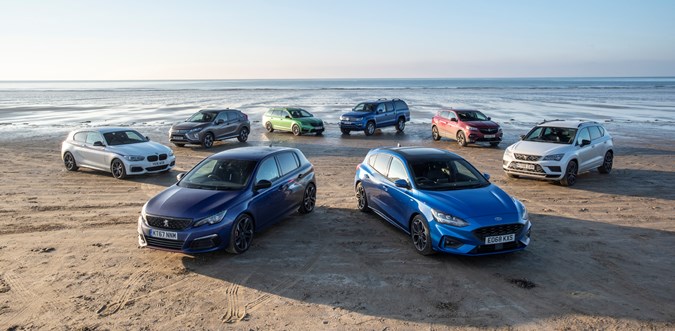
Quite a mixed bunch with a variety of talents – B-road shredders, practical pick-ups and family car cruisers. The Octavia, I reasoned, was a mixture of all of those things, and therefore the best.
I wasn’t expecting everyone to agree, but in fact I (and most of the team), came away with even more appreciation for our green wagon than before we left, as I will now explain.
How was it on the motorway?
I’ve done a fair few long trips in this Octavia (and the blue car before it) so wasn’t expecting to learn all that much that I didn’t know already this time around. The driving position is ideal, the seats squashy, yet supportive enough to resist backache, and the DSG automatic gearbox happy enough to be left to its own devices so you can be lazy with your left leg.
It’s not perfect though – a combination of a seemingly small petrol tank and low 30s mpg means realistically an average of 300 miles per tank, and there’s quite a bit of road noise from the tyres.
The latter can be drowned out with music and the former just means you get to stop for food more often, so really neither is a massive hardship. What is impressive is the ride on our 18-inch wheels and optional adaptive dampers. It really is tricky to tell this car is a sporty vRS on a long drive – there is absolutely no compromise in terms of ride quality.
And on twistier roads?
Our road trip took us into the heart of Snowdonia, for a blast down the B4391 – a country road that manages to be tight and technical as well and open and sweeping, with gradient change, on- and off-camber corners and tricky crests to navigate. All you could want, really.
I’ll be honest – I’ve never thought of the Octavia as being in the same league as things like our 308 GTi or M140i in territory like this. Sure it’s fast and very capable thanks to turbocharged 2.0-litre engine and limited slip differential, but it’s not quite as focussed as those, or even the Golf GTI upon which it is based.

But actually of all the cars we drove on our trip it was my absolute favourite – the chassis is supple over undulating terrain allowing it to follow the road without catapulting you into the undergrowth, and yet there’s a firm edge as you approach the limit of the suspension’s travel. There’s enough power from the engine to enjoy without losing your licence and the steering is weighty and accurate too. It was absolutely fantastic fun.
The limited slip differential on this vRS is well worth the extra cash, bringing with it a much more dependable front end. The blue car used to wash wide in corners, sometime unpredictably in the wet, while this model allows you to turn in to corners at much higher speeds. Weirdly though our less powerful vRS long termer felt faster – potentially because you could leave that car in gear and wait for the massive woosh of torque from the turbo. This automatic car just shifts down.
Better than the Cupra Ateca?
Of all the cars here the souped up SEAT was perhaps the closest mechanically (being a fellow VW Group car), and most different thanks to its all-wheel drive and SUV body.
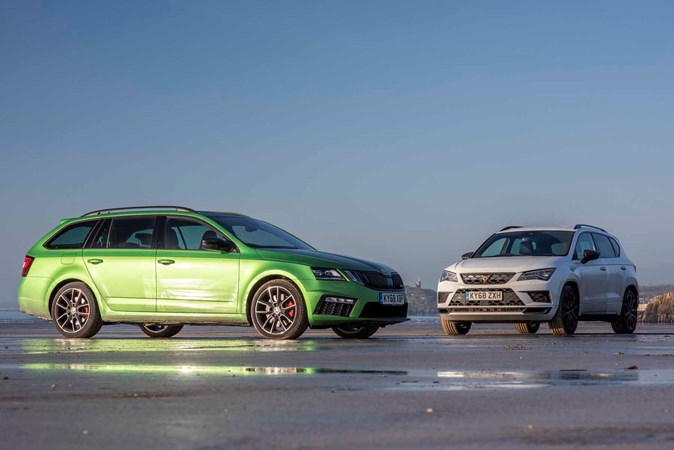
I began the day thinking the Cupra would be the most impressive on our narrow B-road test route given its extra power and grip, but actually the Skoda felt just as planted (in fact, one colleague asked whether it was also AWD) and not noticeably slower. Plus being lower to the road surface meant it felt more agile too. And the Skoda is cheaper. And more green.
The Ateca is a great car and to my mind feels more like a Skoda vRS product – comfortable, practical and easy to use, with a faster edge when needed – than a traditional Cupra model, which always seem a bit compromised in the interest of outright handling. That’s not a bad thing, it just doesn’t excite in the same way as a Leon.
What did everyone else think of the Octavia?
Weekend racer James Dennison said: ‘Of all the cars that we piloted up and down that lovely piece of B-road in north Wales, the Octavia vRS stood out the most for me. Not because it was the best (that honour goes to my Focus or the BMW M140i), but because of how surprisingly un-estate-car like it was.
‘The difference between Comfort and vRS driving modes was pronounced, the green machine feeling every bit the exciting hot hatch in the latter setting. There was even decent feel and poise from the chassis. Top marks Skoda.’
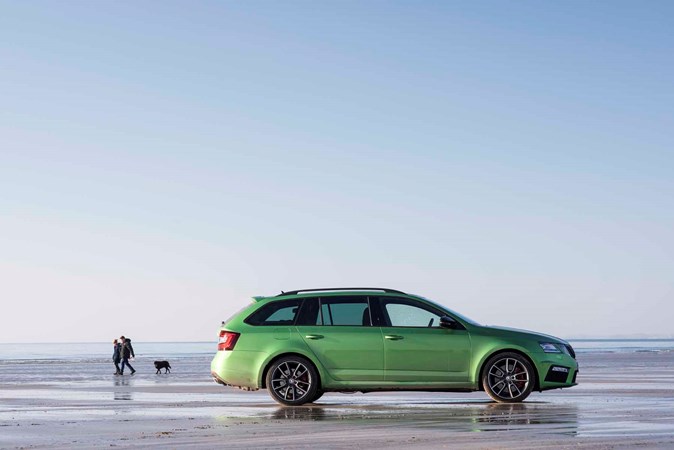
Gothic poet Richard Kilpatrick said: ‘The driving position felt low and the seat had minimal adjustment, but aside from a lack of thigh support there’s nothing to make it uncomfortable. Side support is impressive, a little tight for my shoulders, but that turns out to be very appropriate.
‘Off the mark the Skoda pulls away with little drama and a lot of progresss, and through fast, undulating bends it’s planted and precise. The revelation that this is front-wheel drive is genuinely surprising. Practical, rapid and realistically, able to be specced for more comfort if required, the Octavia is truly impressive.’
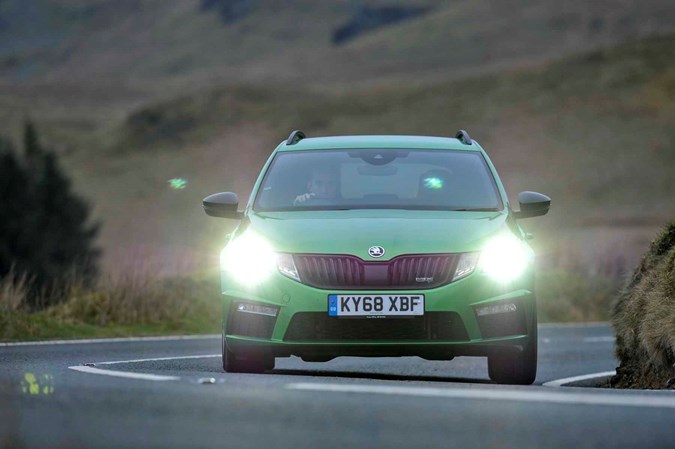
Pleasantly surprised Lawrence Cheung said: ‘Yhe throttle response is sharp and the steering is up there with the Focus for response – if less busy. This was the biggest surprise for me on this road.
‘My long-term 308 GTi did catch up with me, for the record, but I wasn’t having any less fun. I’m not too sure how this would be if I’d pushed any further though, but would that matter to most? Probably not.’
Technophobe Christofer Lloyd said: ‘Hideous digital dials – look staggeringly cheap and nasty. Fast, comfy, planted. Impressive to drive, very capable and satisfying.
‘Very smooth on reasonable roads, but surprisingly firm over not-so-good tarmac. Also throws up a lot of tyre noise. Detracts from long-distance cruising ability.
So there you have it. For my money the BMW M140i was the best hot hatch on our test, while the Volvo S90 was the best mile-munching cruiser.
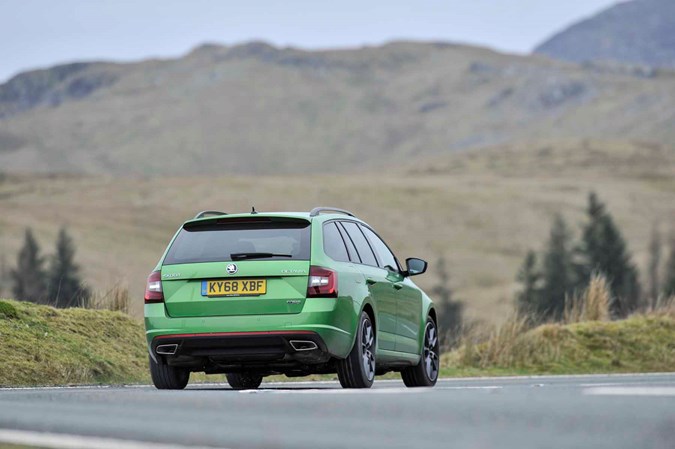
If you want something that does both and costs less than either too, you’ll have to get an Octavia.
Update 3: Comfort and practicality
Just like the blue car that came before it, the green Octavia vRS Estate and I have been racking up some serious miles on the road, quite often accompanied by my bike, and if anything this version is even more satisfying to use as a cycle support vehicle.
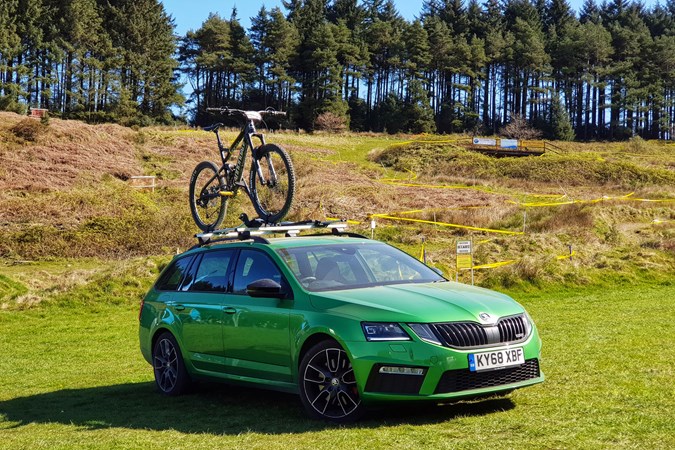
I won’t bore you by repeating the findings so well documented during our time with our previous Octavia (read them for yourself here) but there are a few differences worth bringing up.
The roof rack – itself a carryover from my previous long termer – is super easy to attach to the car’s roof bars (although because I’m lazy I just leave it on) and then it’s just a case of heaving your bike onto it. Easier than loading it into the boot of my mate’s Honda Civic Type R, that’s for sure.

During our time with it one of the rack’s slideable plastic wheel-holders snapped off from one of the carriers (if you’re reading this Skoda Press Office, I need to post this back to you) which is a bit disappointing given the bike rack is only a year or so old. In fairness, it gets a lot of use and my bike is pretty heavy.
Anyway, by way of properly testing the car’s comfort and practicality I loaded it up with bike and family and drove to Wales for a weekend away. One that just so happened to coincide with an enduro mountain bike race I had entered at my favourite trail centre in Afan.
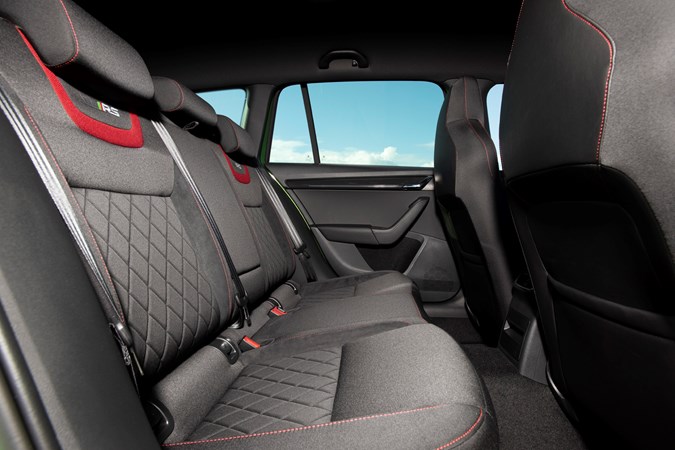
One thing the Octavia does incredibly well (better than the slightly shorter Golf upon which it is based) is completely swallowing our bulky Isofix car seats – one of which has a leg that sticks out into the rear footwell and seriously impedes on the front passenger’s legroom. That’s not a problem in the Skoda, which has a huge wheelbase and makes this a problem of the past.
Also huge is the boot – again, no different from the blue car’s but worth a mention not only for its outright size, but also for the plethora of useful hooks to hang things like helmets and bags from, plus a storage bin for tools on the left. Not forgetting, of course, the remote levers to collapse the rear seats without having to walk around to the side doors.
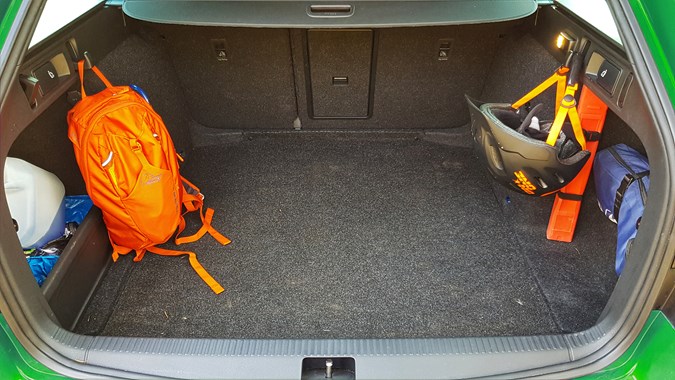
The format of the race I’d entered meant only your times down the hill counted, so while it didn’t matter how fast you pedalled back up, there was still a lot of work to do and consequently I was absolutely done in by the end of the day.
What a relief it was to sink into the Octavia’s squashy, heated driver’s seat and waft home. I struggle for headroom in a lot of cars and that means I end up slouching or sitting at an awkward angle that brings on terrible back pain, but the low-slung position in this Skoda is just right.
When you want to make smooth and comfortable progress the Octavia’s powerful engine, decisive gearbox and sublime ride combine in what must be one of the most easygoing performance cars on the market.
My only complaint would be there is quite a bit of road noise on the motorway – I reckon this could be the Bridgestone tyres the car comes with. We had the same rubber on a Golf GTE long termer and transformed the car by swapping them out.
A final mention of note – the huge boot I mentioned earlier is in fact so big you can hide from the rain during a particularly soggy ride and eat Thai takeaway from a van while all your mates get wet. This car is basically the dream.

Update 4: Three generations of Octavia vRS driven
The Skoda Octavia celebrated its 60th birthday this year – it’s been a hugely successful car during that time, with 6.5 million models sold worldwide. Half a million of those found homes in the UK.
In 1959 your Octavia featured sophisticated (for the time) coil spring suspension and a 1.1-litre four-cylinder engine that put out 40hp. It proved popular with UK buyers, particularly the estate version with its split tailgate and 1,050-litre boot. That’s a trend reflected in the current car, of which nearly half of all sales are wagons.
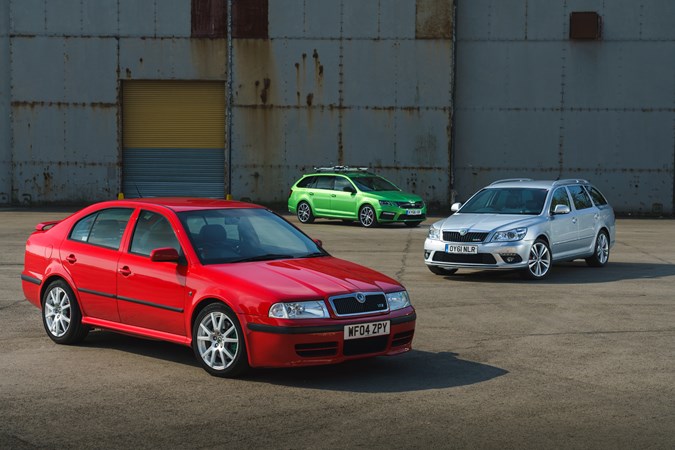
What’s really interesting though is the fact that a remarkable 20% of Octavias sold in the UK are vRS models, like mine. So how does our car compare to its predecessors? We’ve been driving Skoda UK’s meticulously maintained first and second generation Octavia vRS pairing to find out.
New generation Octavia Mk1 (1996 – 2004)
The reborn Octavia came five years after the buy-out by Volkswagen Group and offered a mixture of Golf tech and mechanicals with a more palatable price. Demand was strong – so much so that we had to wait until 1996 for UK cars. Across its lifetime nearly 1.5 million cars were made, 78,839 of which found their way over here.
In 2001 the first vRS model arrived – with a turbocharged 1.8-litre petrol engine producing 180hp. At the time it was the fastest production Skoda with a 0-62mph of 6.7 seconds and top speed of 144mph.
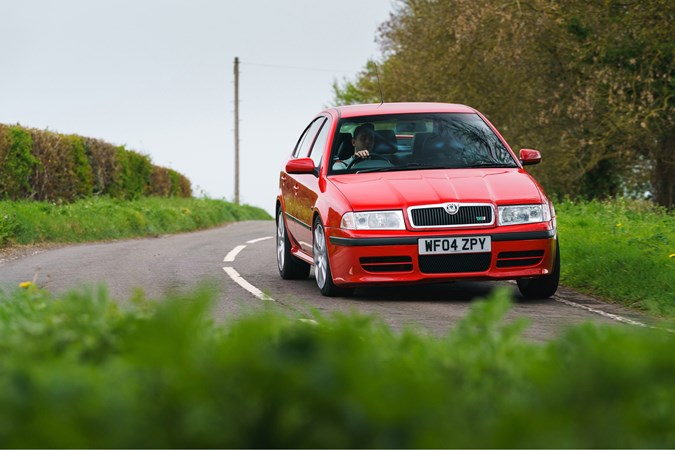
The hatchback I drove belongs to a different age – it was registered in 2004 and has been on Skoda UK’s heritage fleet since 2014, but it’s surprisingly easy to draw similarities between this car and ‘my’ modern Octavia.
It’s super easy to drive with a low dashboard that is easy to see over and big, clear dials. The control weights are light and the slick gearchange has a longish throw (like the manual vRS we ran previously) and even longer ratios – on a fast road you’ll only need second and third gears. The steering feels a little numb until you’ve turned the wheel off the centre but weights up nicely after that.
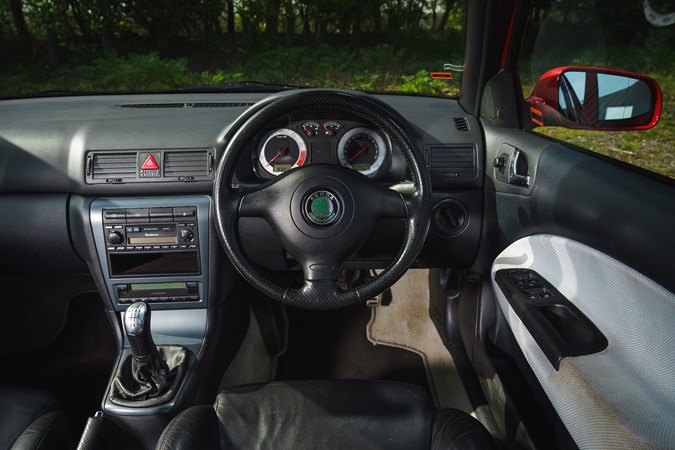
Some of the polish of our car is missing – there’s a bit of torque-steer, especially over rough ground, and the engine takes a bit of work to get into its stride, resulting in a surge from the turbo. It feels way more powerful than 180hp would suggest though, pulling properly hard up to peak power at 5,500rpm.
The roots of the easy-going performance in our car are easy to see too – soft bucket seats are supportive but comfortable, and the ride on 17-inch wheels is wafty without compromising outright body control. Our adaptive dampers allow a sportier set up if you fiddle around with the drive modes, but in all honesty it’s quite nice to just get in a car that works well out of the box.
Around the back there’s a huge boot but diagonal bracing either side looks like it would compromise the seats-down capacity, which is surprisingly un-Skoda, and the rear seat legroom is dwarfed by our car. The interior is a bit plasticky, especially on the door tops and air vents, but that’s all part of the charm.
On the whole the original Octavia vRS is – spoiler alert – my favourite version. Just look at those awesome green brake calipers. You won’t be surprised to hear I’ve been searching the classifieds for a tidy, banana-yellow estate ever since.
Octavia Mk2 (2004-2013)
The car garnered even more sales with 2,274,529 cars built after 2004’s Geneva Motor show reveal and 130,662 registrations in the UK.
A substantial improvement in the quality of interior materials, the availability of a 2.0-litre turbodiesel engine and DSG automatic gearbox made the second generation Octavia (and vRS) a much more tempting company car.
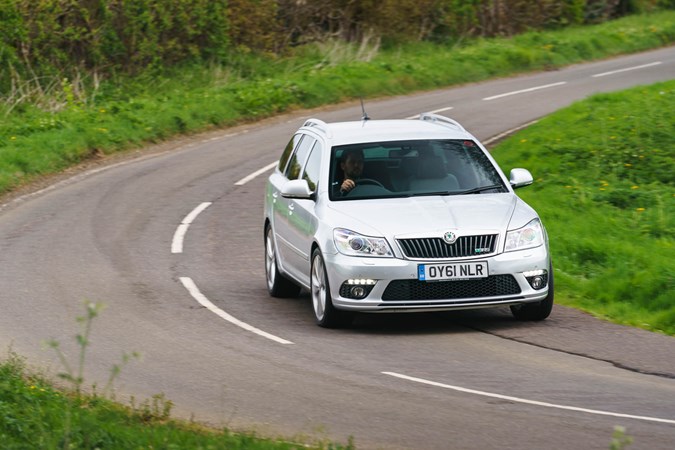
This version features the more sought-after common rail unit, available as part of the 2011 facelift, and puts out 170hp, and more importantly 350Nm of torque. This resulted in a 0-62mph time of 8.1 seconds.
It only weighs 155kg more than the petrol Mk1 but this car feels more substantial in all areas – there’s more heft to the steering (itself featuring a much girthier rim) and even the doors need a strong pull to open and shut.
Despite this it promises 49.6mpg over the previous car’s 35.2mpg – a sizable improvement for a car that feels just as fast on the road. It’s not as fun to drive though I reckon, feeling a bit more lumpen and lethargic, perhaps because of that automatic gearbox.
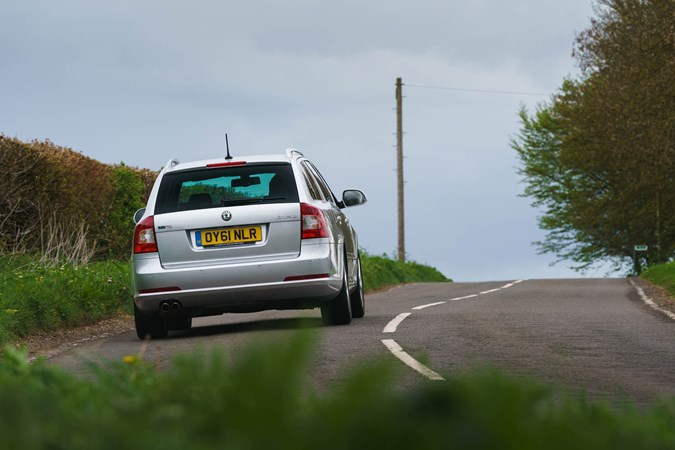
The ride is also quite a bit firmer and the seats a touch grippier in their bolstering. The petrol version is probably quite a weapon, but would be ideal as a business-class cruiser with sporty styling and more performance than boggo saloons of the era.
To that end you get a much smarter interior with more soft-touch plastic and brushed aluminium trim, plus loads of buttons for the new gadgets and integrated sat-nav screen. The rear legroom is more generous and you get a set of door mirrors that are so large they could have come off a van. Very handy for towing a caravan, I’d bet.
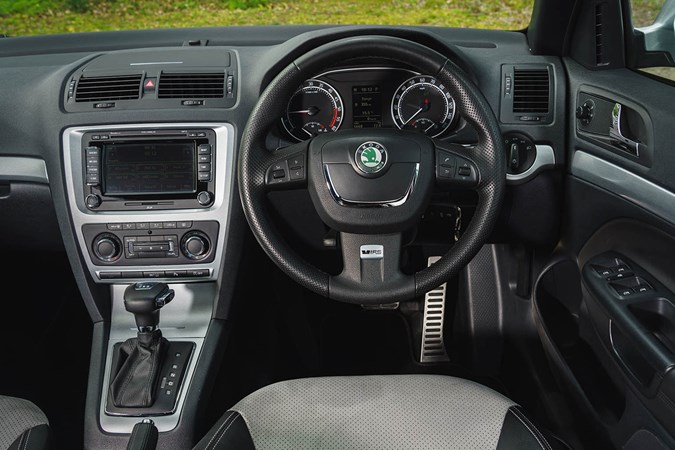
Basically I didn’t like it as much as the Mk1. That impression may have come across already.
Octavia Mk 3 (2013-)
Of these three vRS models the current car is easily the most capable and well-rounded – that petrol engine feels like it has undergone years of refining (largely because it has) and the tech on offer now dwarves what was available in 2001.
For all those reasons though, as I said earlier, for an enthusiastic drive I think I prefer the first generation car. It’s such a simple thing to enjoy and thanks to nearly two decades of maturing now has loads of modern classic appeal too.
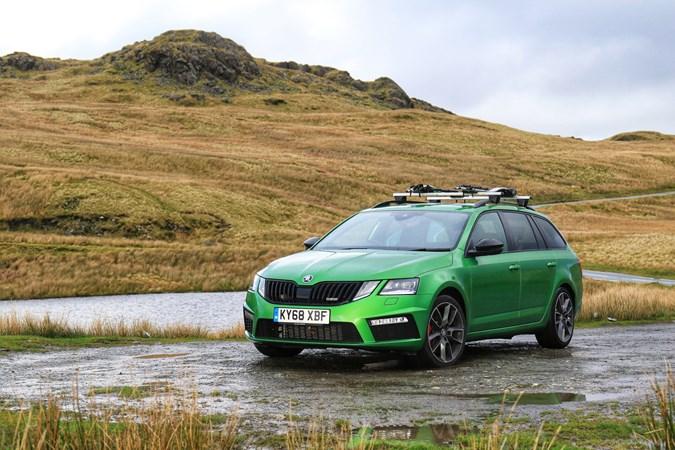
To live with though it’s now so hard to criticise the current car. Huge amounts of boot and passenger space, super-saloon baiting performance and a chassis that can offer you everything between a soothing ride to hunkered-down cornering. Some things really do get better with age.
Update 5: Interior and options
It’s unlikely to have escaped your notice, even in pictures, just how dark the Octavia’s cabin is – only the red stitching gives it a lift.
People mention it when they get in the car and initially this bothered me, but after nearly six months with this Skoda I’m beginning to build a case for its restrained design.
For one thing, how long do you actually spend looking at the interior of the car you’re driving instead of the road? A truly successful design surely needs to simply go unnoticed – especially in a car with the performance of this vRS.
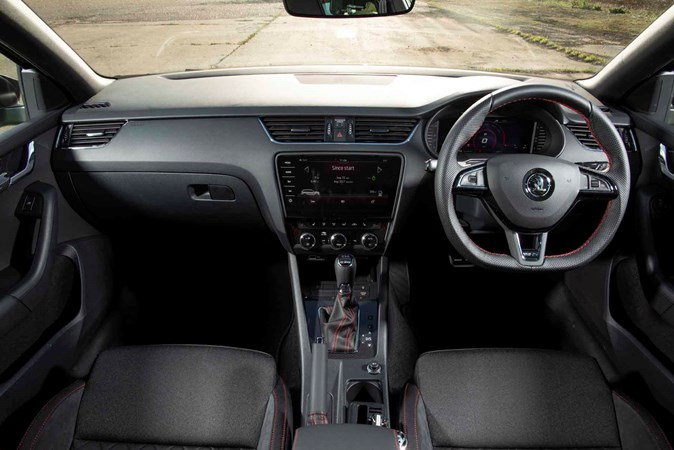
Secondly, while it’s not particularly exciting to look at, the Octavia’s interior has been put together with typical VW group accuracy, and in terms of ergonomics it is very easy to use.
There are some caveats to that – the wheel isn’t round or flat-bottomed, but rather a mixture of both, and this gripes me more than I’d like to admit. The handbrake is also curiously positioned on the passenger’s side, and is starting to feel very old-school in a world of electronic parking brake buttons.
The rubber multi-slot thingybob holder is too small for my phone and renders the other cupholder useless, so that’s gone in the glove box, and I can’t decide if the carbonfibre-effect trim is cool or a bit much.
Bottom line really is the Octavia’s interior is functional but lacking flair – stylistically at least – and starting to feel a bit dated. Especially if you don’t pick some of the following options.
What options have you got and which are worth it?
This car has quite a few bits added to it, unlike the basic blue vRS we ran previously, which had no options. On top of this little lot I’d consider a Canton stereo upgrade and panoramic roof.
Keyless entry and start (£405): A time-saver when you’re carrying a child and a changing bag and god knows what else. Who wants to be fumbling around for a key in that situation? Not you. Verdict: Essential.
Virtual cockpit display (£450): Gives the cabin a huge high-tech lift and means you can beam info right into your eyeline. Some of the graphics are a bit naff, but the central rev-counter mode can be activated on the move, unlike an Audi. Verdict: Not essential, but quite cool.
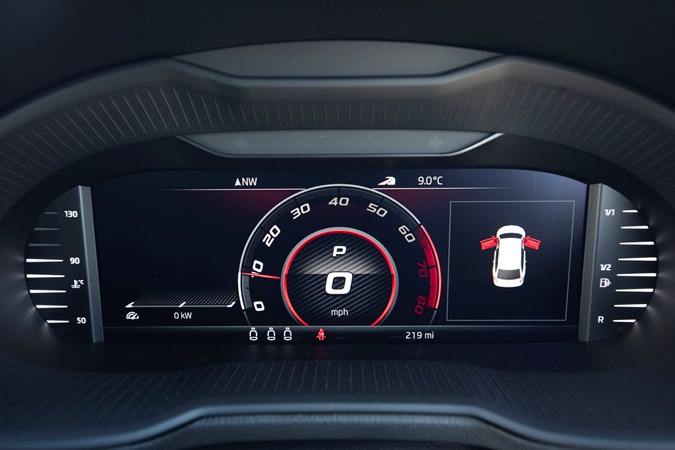
Columbus 9.2-inch touchscreen (£1,060): Bigger and clearer than the standard screen and allows you to display an bird’s eye sat-nav map of your entire journey in the centre of the car and turn-by-turn map on the Virtual Cockpit. Then when a child asks you how long the journey is, you can simply gesture at the screen. You do lose the manual volume knob though, because everything is touch controlled. Verdict: Not essential.
Heated front seats (£255): I’ll be honest, these are a no-brainer because they stop my back from aching. Do you have an achy back? These are cheaper than a physiotherapist. Verdict: Essential.
Intelligent light assistant (£315): Not a matrix LED system but rather a clever sensor that fires your full beams into action when it gets dark enough. Trouble is, that didn’t happen nearly often enough to justify the pricetag. Verdict: Don’t bother.
Dynamic chassis control (£860): Our car was built in an odd WLTP greyzone and therefore came with 18-inch wheels. As a result my long termer with its adaptive dampers rides like it’s on a marshmallow road. Yours will have 19s. This DCC option gives you the option of a comfortable or tied down ride, and therefore…Verdict: Essential
Rallye Green metallic paint (£435): Contentious one, this. The blue vRS was more satisfying to drive because people often though you were a Police car and gave you a wide berth. This is a bit more boy-racer, and my suspicion is people see it and think, good grief, look at that tool. It looks cool though, and is a nice talking point among petrolheads. Verdict: Not essential.
Temporary space saver spare wheel (£110): Try to repair a sidewall slash with one of those little pumps of sealant. You cannot. Now you’re sleeping in the car waiting for the breakdown truck to trundle towards you, while I’m thundering home (not actually) on my spacesaver. You dork! Verdict: Essential.
Electrically operated boot (£405): Don’t judge me but the Octavia’s bootlid is actually quite heavy to close and this makes life dramatically easier. Plus you can trigger if from miles off, to radically slice faffing time when carrying lots of heavy items. Verdict: Essential.
Update 6: Farewell and verdict
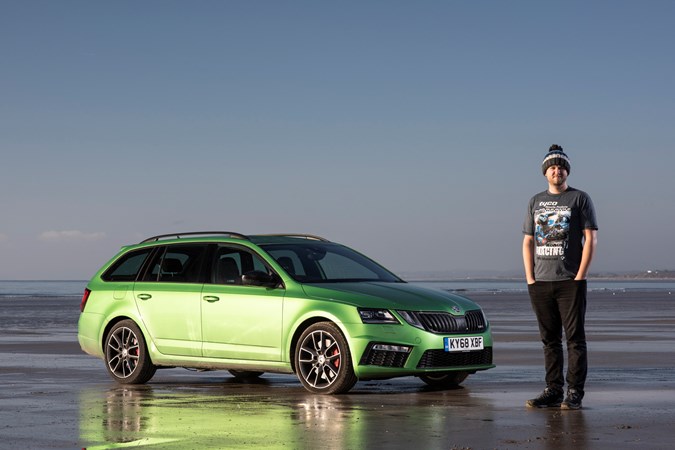
Time’s up with my Skoda Octavia vRS Estate long termer – this is going to be quite a painful update given how much I like this car, so let’s not dwell on the fact it has been driven out of my life for good and focus on some of the positives. And indeed negatives.
Performance and handling
During six months and 12,000 miles of ownership the novelty of the Octavia’s surprising straight line speed didn’t fade. That said, I’ve since driven a manual vRS 245 (the blue car we ran previously had 230hp) and am now fully convinced the automatic feels the slower of the two, even though on paper it’s faster. I think that’s because you can leave the three pedal car in-gear and let the torque build steadily. When you floor it in the DSG you get a noisy response that doesn’t quire seem to match the accompanying shove.
At the time of writing you could no longer get the lower powered vRS without the limited slip differential we’ve got on our car, so this might not be the most useful advice, but the extra front wheel grip this gives you is worth every penny. I still think the Bridgestone tyres are the limiting factor though, particularly in the wet – the rubber supplied with the larger 19-inch alloys offers substantially more cornering adhesion in exchange for a slightly worse ride. Personally I’d get the 18s and accept the traction penalty, for reasons we’ll get onto.
Fuel economy
Really not this car’s strong point, especially when you consider the fuel-sipping nature offered by the rest of the Octavia range, as we averaged 32.2mpg over the course of our test. The best and worst tanks ranged between 36.3mpg and 27.9mpg, with things improving ever so slightly on weeks where I had a long motorway journey to complete.
A caveat though – this car spent almost the entire time here at Parkers wearing a roof rack, and most weekends had a bike on top too. Without these you should expect an average fuel economy in the mid-30s, creeping up to the 40s if you purchase some helium shoes. I enjoyed driving this Octavia rather too much and I think this shows in those numbers. Ahem.
Comfort and practicality
Aside from the performance this is where the vRS shone the brightest as you’d expect, being based upon arguably the best all-round platform for space and well-being short of an S Class Estate (which doesn’t exist). The boot took whatever we threw into it thanks to its deep well of space and the rear passenger legroom meant adults or children in large Isofix seats could stretch out, despite my long-legged driving position.
The combination of adaptive dampers and 18-inch wheels meant a sublime ride most of the time, only upset by really crap tarmac, that could instantly become sporty-stiff at the push of a button. Now when I bring supposedly comfortable cars home, within a couple of miles my wife will have informed me that ‘it doesn’t ride as well as the Octavia’.
One downside – I’ve complained about the grip from the tyres already but it’s also worth mentioning the noise they make on the motorway, piped directly into the cabin without having to go through the layers of sound-proofing you’d get in a Golf.
Interior and options
The slight dourness of the Octavia’s cabin mattered less and less to me as time went on – but if you’re the kind of driver who wants all of the latest tech then this Skoda’s aging platform means rivals offer a more complete package. I found the vRS in our spec covered all the bases though, not being that fussed about a reversing camera or matrix LED headlights and so on. You might want to check the brochure carefully to make sure all your desires are met.
Verdict
For a while I’ve been trying to think of something that could replace the Octavia shaped hole in my life given an unlimited budget, and have settled on needing two cars – a practical one and a fun one, or an Audi RS 6. Which costs the same as two cars.
If you simply want one car that does 99% of what you need day-to-day then picking this Octavia vRS Estate is the easiest decision you’ll ever make.
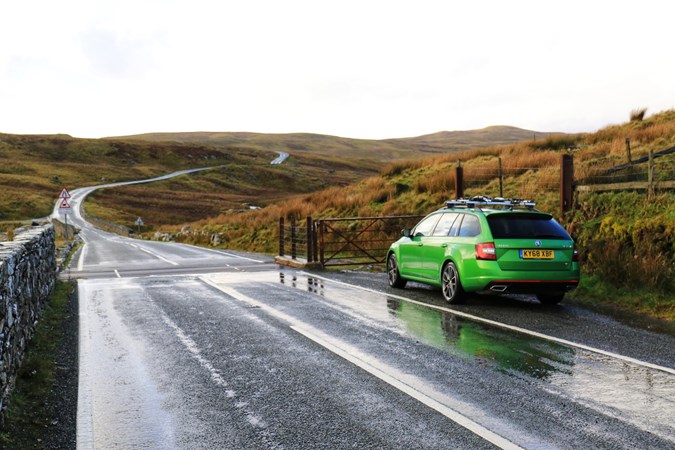




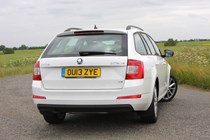
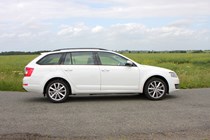
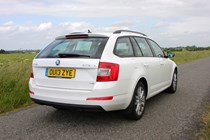
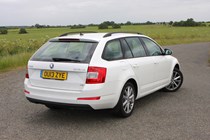
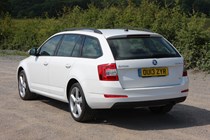
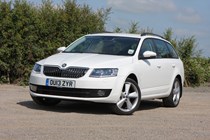
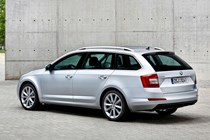
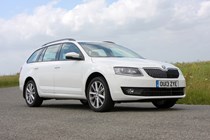
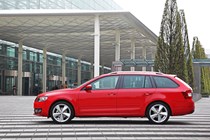
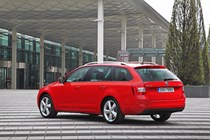

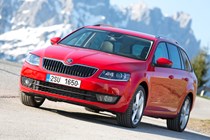
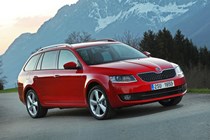
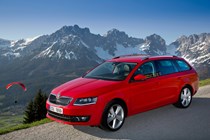
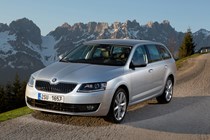
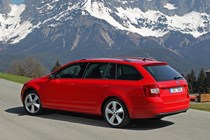
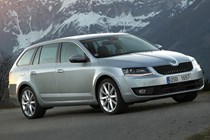
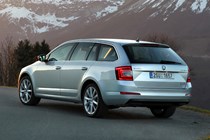
.jpg)
.jpg)
.jpg)
.jpg)
.jpg)
.jpg)
.jpg)
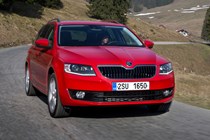
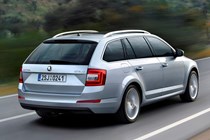

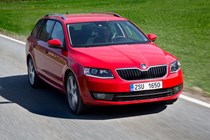

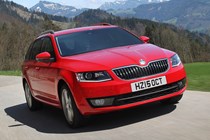
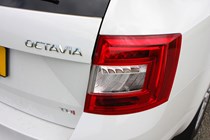
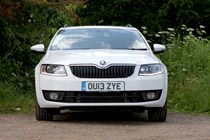
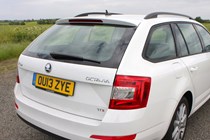
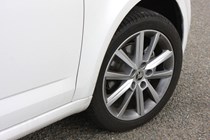
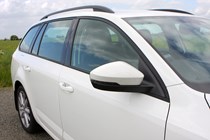
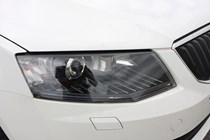

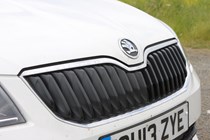
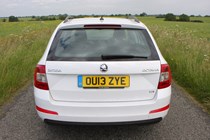

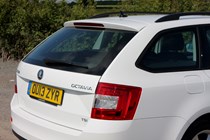
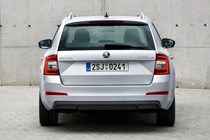
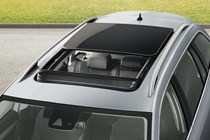
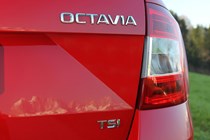
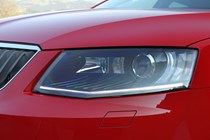
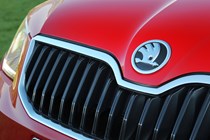
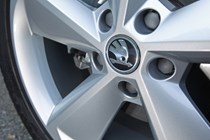

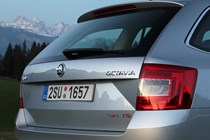
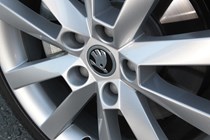
.jpg)
.jpg)
.jpg)
.jpg)
.jpg)
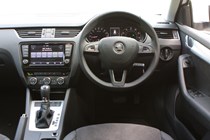
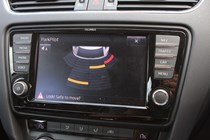
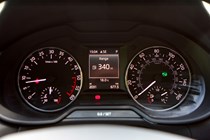
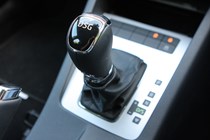
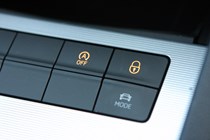
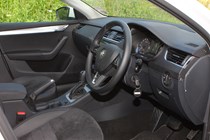
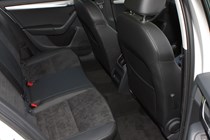
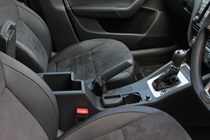
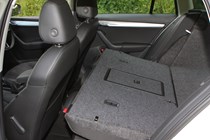
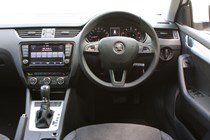
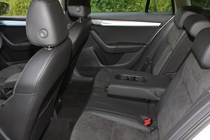
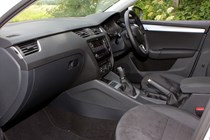
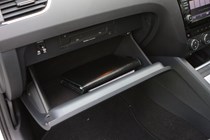
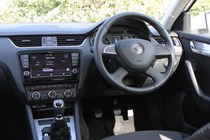
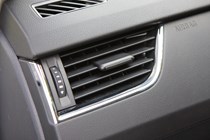
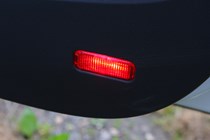
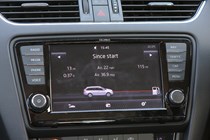
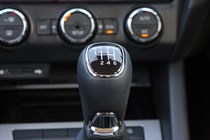

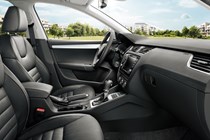
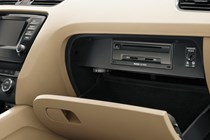
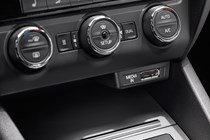
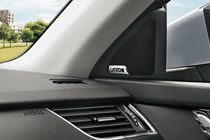
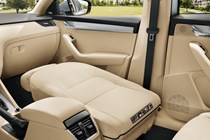
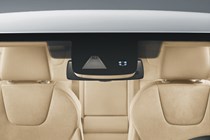

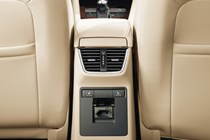
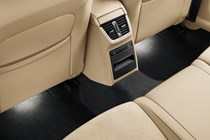
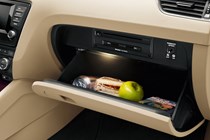
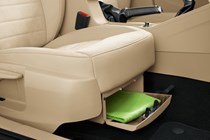
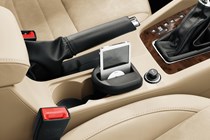
.jpg)
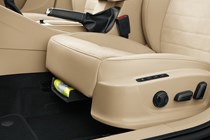
.jpg)
.jpg)
.jpg)
.jpg)
.jpg)
.jpg)
.jpg)
.jpg)
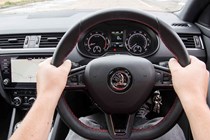
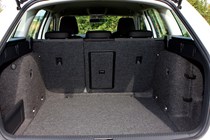

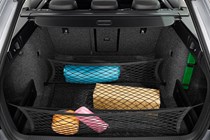
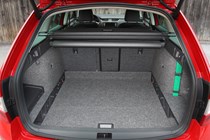
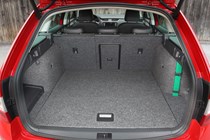

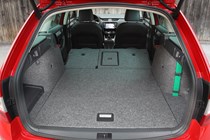
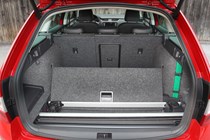
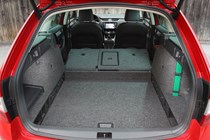
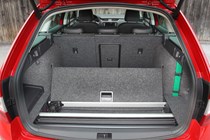
.jpg)
.jpg)
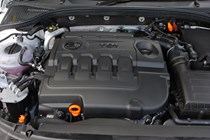

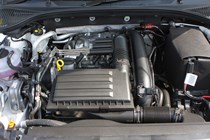
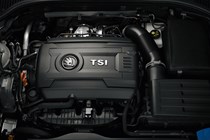
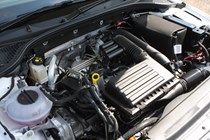
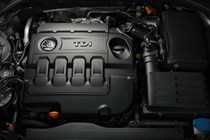
.jpg)
.jpg)
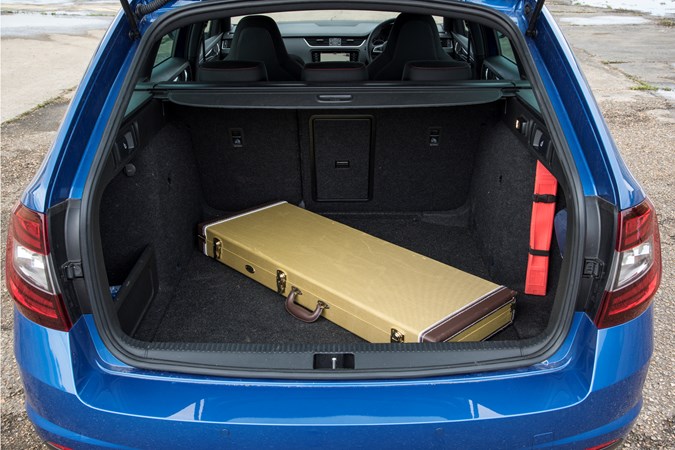






















.jpg?quality=50)
.jpg?quality=50)
.jpg?quality=50)
.jpg?quality=50)
.jpg?quality=50)
.jpg?quality=50)
.jpg?quality=50)


























.jpg?quality=50)
.jpg?quality=50)
.jpg?quality=50)
.jpg?quality=50)
.jpg?quality=50)































.jpg?quality=50)

.jpg?quality=50)
.jpg?quality=50)
.jpg?quality=50)
.jpg?quality=50)
.jpg?quality=50)
.jpg?quality=50)
.jpg?quality=50)
.jpg?quality=50)











.jpg?quality=50)
.jpg?quality=50)






.jpg?quality=50)
.jpg?quality=50)